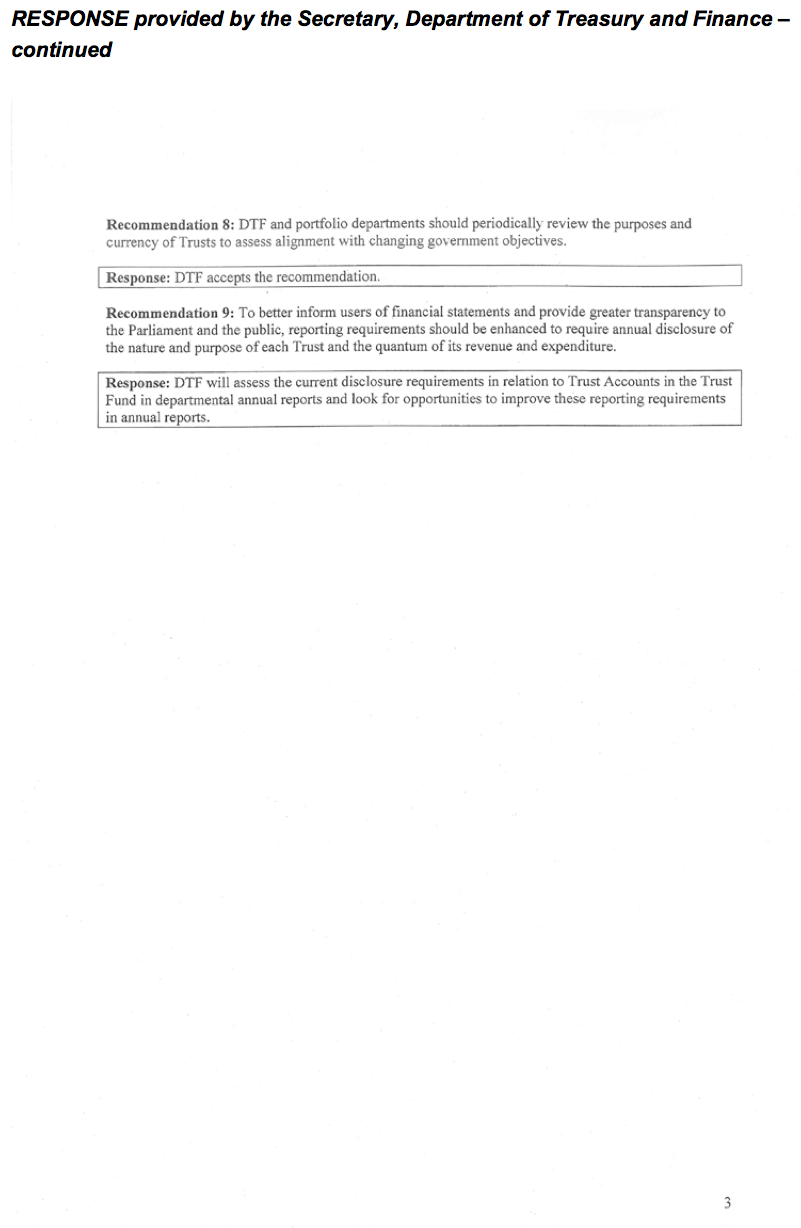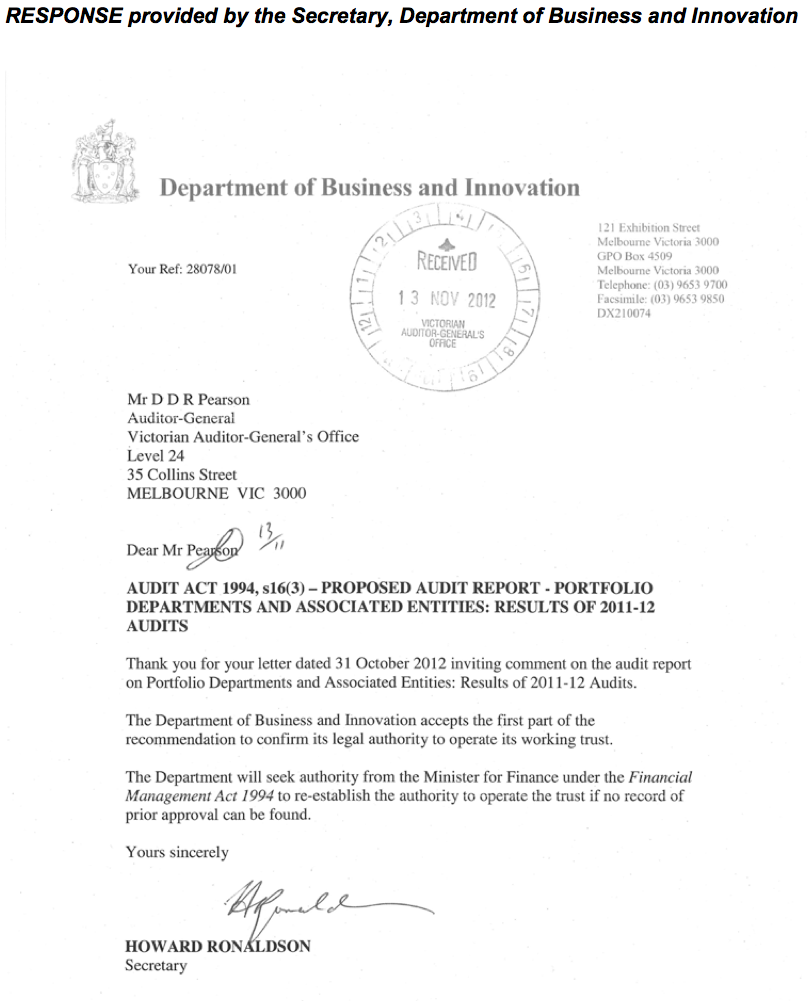Portfolio Departments and Associated Entities: Results of the 2011–12 Audits
Overview
This report presents the outcomes and observations from the external financial audit of 11 portfolio departments and 193 associated entities. Additionally, it comments on the quality of financial reporting, the financial sustainability of self-funded state entities and the effectiveness of internal controls over the appropriation framework, trust funds and risk management.
Financial reporting by the portfolio departments and associate entities is reliable. However, shortcomings were observed in the control frameworks governing appropriations and trust funds, and of disclosure of post-employment remuneration and ex gratia payments.
Portfolio Departments and Associated Entities: Results of the 2011–12 Audits: Message
Ordered to be printed
VICTORIAN GOVERNMENT PRINTER November 2012
PP No 198, Session 2010–12
President
Legislative Council
Parliament House
Melbourne
Speaker
Legislative Assembly
Parliament House
Melbourne
Dear Presiding Officers
Under the provisions of section 16AB of the Audit Act 1994, I transmit my report on Portfolio Departments and Associated Entities: Results of the 2011–12 Audits.
Yours faithfully

D D R PEARSON
Auditor-General
28 November 2012
Audit summary
This report presents the outcomes and observations from the external financial audit of 11 portfolio departments and 193 associated entities. Additionally, it comments on the quality of financial reporting, the financial sustainability of self-funded state entities and the effectiveness of internal controls over the appropriation framework, trust funds and risk management.
Conclusion
Financial reporting by portfolio departments and associated entities is reliable. However, shortcomings were observed in the control frameworks governing appropriations and trust funds, and of disclosures of post-employment remuneration and ex gratia payments.
Quality of financial reporting
The Financial Reporting Direction (FRD) to public sector entities covering the reporting of responsible person and executive officer remuneration has a narrow definition of remuneration.
As a consequence, three public sector bodies, including one portfolio department, were able to limit disclosure of information relating to post‑employment benefits paid to former responsible persons.
The requirement to report ex gratia payments made by a public sector entity is similarly covered in an FRD. The requirement, however, is minimal and allows public sector agencies to exercise significant discretion over the level of disclosure made on the nature and reasons for the payments.
Financial sustainability
The financial sustainability of 46 self-funded state entities was assessed using four indicators that consider both short-term and long-term sustainability. The assessment flags short-term financial risks for 13 entities and long-term financial risks for a further 16 entities. This result is consistent with prior years and indicates continuing challenges for these entities to generate revenue from operations to fund asset replacement.
The appropriation framework
The principal source of funding for the general government sector is through the annual Appropriation Act, which in 2011–12 allocated $39.2 billion to the 11 portfolio departments.
The funding for portfolio departments is based on a purchaser-provider model, where appropriations are awarded by the Treasurer for the delivery of services to an agreed output standard. At 30 June 2012, portfolio departments had delivered 71.4 per cent of the agreed output targets for the financial year, but 99.97 per cent of requested appropriations were awarded. It is not evident that there are adverse consequences for underdelivery or non-delivery.
Portfolio departments can generate a surplus by delivering outputs at a cost less than the agreed level. Surpluses can be accumulated and used to deliver additional public services or infrastructure above those funded annually by appropriation. Portfolio departments report the accumulated amount as a receivable in their financial statements; operationally, it is referred to as the state administration unit (SAU).
At 30 June 2012, $1.4 billion was available across the 11 portfolio departments to deliver additional public services and infrastructure. Nevertheless, no portfolio department other than the Department of Health could demonstrate strategies to use these reserves in the current economic climate.
Where required, portfolio departments can access additional funds to meet urgent expense claims which are unforeseen and therefore not provided for in the Budget. Commonly known as Treasurer’s advances, this emergency funding is permitted under the Appropriation Act, where money is set aside as an ‘advance to Treasurer to enable Treasurer to meet urgent claims that may arise before Parliamentary sanction is obtained, which will afterwards be submitted for Parliamentary authority’.
During 2011–12, the Treasurer approved 48 Treasurer’s advances with a total value of $776 million. Over the past five years, 56 per cent of the Treasurer’s advances awarded have been to assist portfolio departments in meeting wages, depreciation, administration costs and capital projects. These types of expenses are routine, yet the use of Treasurer’s advances to meet them is inconsistent with the Appropriation Act, which provides for Treasurer’s advances to be used only for urgent expenditure which is unforeseen.
Trust funds
Trust funds are discrete accounts established to record the receipt and disbursement of state funds for specified purposes. They can be set up under their own legislation or by the Minister for Finance under the Financial Management Act 1994.
At 30 June 2012, 111 trust funds were held across the 11 portfolio departments, with a total value of $2.7 billion. The number and value of trust funds held is growing year on year, however, with one exception, portfolio departments and the Department of Treasury and Finance (DTF) (on behalf of the Minister for Finance) could not demonstrate they had systematically reviewed the nature and purpose of each trust to confirm relevance and alignment with the strategic objectives of government.
There is evidence that treasury trust funds are not being used as intended. Treasury trust funds are established to hold unclaimed and unidentified money, however, there is evidence that revenue and appropriations are being deposited, and expenses raised, out of these trust funds. Further, the Department of Business and Innovation is operating a working trust; however, neither the department nor DTF could provide evidence that the trust had been legally established.
While trust fund balances are reported by portfolio departments in their financial statements at the end of each financial year, there is no public reporting of the amount of money flowing into and out of each trust annually. There is also no disclosure of the nature and purpose of each trust. Consequently, there is a lack of transparency in reporting to Parliament on trust funds.
Risk management
The risk management practices at the 11 portfolio departments are adequate, with general compliance against the Victorian Government Risk Management Framework and the international risk management standard. Further improvements in risk management could be achieved by portfolio departments strengthening risk management policies and training.
An annual attestation on compliance with the international risk management standard has been required since 2007. Three portfolio departments are still developing or improving their risk management controls and framework.
Recommendations
- The Department of Treasury and Finance should:
- revise Financial Reporting Direction (FRD) 21B to align the disclosure of remuneration of responsible persons and executive officers with Australian Accounting Standards for private sector entities
- revise FRD 11 to mandate meaningful disclosure of the nature, purpose and amount of ex gratia payments made by public sector entities.
- The implications of the financial sustainability challenges for the accountability of boards, councils and trusts should be reviewed, and a strategy to address them developed.
- The Department of Treasury and Finance should review the implementation of the appropriation framework to determine whether acquittal and approval procedures are delivering funding outcomes consistent with its aims.
- Portfolio departments should, in consultation with the Department of Treasury and Finance, include in their long‑ and short-term plans a clear link between the use of the accumulated state administration unit balances, and the provision of additional services to the public, and infrastructure, consistent with the model.
- The Department of Treasury and Finance should adopt a definition of urgent that would mean that Treasurer’s advances are awarded only for purposes consistent with the Appropriation Act.
- The Department of Treasury and Finance should:
- review every treasury trust fund to determine whether it is being used as intended, and address noncompliance as necessary
- review its trust fund guidelines for consistency with better practice.
- The Department of Business and Innovation should confirm its legal authority to operate its working trust or close the trust.
- The Department of Treasury and Finance and portfolio departments should periodically review the purpose and currency of trusts to assess alignment with changing government objectives.
- To better inform users of financial statements and provide greater transparency to the Parliament and the public, reporting requirements should be enhanced to require annual disclosure of the nature and purpose of each trust and the amount of its revenue and expenditure.
- That portfolio departments should:
- review and approve risk management policies annually
- conduct regular tailored training for all staff on risk identification and management
- act decisively to address areas of noncompliance with the risk management standard.
Submissions and comments received
In addition to progressive engagement during the course of the audit, in accordance with section 16(3) of the Audit Act 1994 a copy of this report, or relevant extracts from the report, was provided to all portfolio departments and named agencies with a request for submissions or comments.
Agency views have been considered in reaching our audit conclusions and are represented to the extent relevant and warranted in preparing this report. Their full section 16(3) submissions and comments are included in Appendix F.
1 Background
1.1 Introduction
This report covers 11 portfolio departments and 193 associated entities with 30 June 2012 balance dates. These entities report under a range of legislation, the most common being the Financial Management Act 1994 (FMA) and the Corporations Act 2001. Figure 1A shows the number of entities per portfolio and legislative reporting framework.
Figure
1A
Entities by portfolio and legislative reporting framework
Financial Management Act |
Corporations Act |
Other |
Total |
|||||
|---|---|---|---|---|---|---|---|---|
Portfolio |
2011–12 |
2010–11 |
2011–12 |
2010–11 |
2011–12 |
2010–11 |
2011–12 |
2010–11 |
Parliament |
2 |
2 |
– |
– |
– |
– |
2 |
2 |
Business and Innovation |
7 |
7 |
5 |
5 |
– |
– |
12 |
12 |
Education and Early Childhood Development |
6 |
6 |
2 |
3 |
– |
– |
8 |
9 |
Health |
15 |
14 |
– |
– |
1 |
1 |
16 |
15 |
Human Services |
2 |
3 |
– |
– |
– |
– |
2 |
3 |
Justice |
26 |
25 |
2 |
2 |
2 |
1 |
30 |
28 |
Planning and Community Development |
13 |
13 |
1 |
1 |
– |
– |
14 |
14 |
Premier and Cabinet |
11 |
11 |
1 |
1 |
– |
– |
12 |
12 |
Primary Industries |
10 |
10 |
2 |
2 |
1 |
1 |
13 |
13 |
Sustainability and Environment |
38 |
36 |
– |
– |
– |
– |
38 |
36 |
Transport |
10 |
8 |
7 |
6 |
– |
– |
17 |
14 |
Treasury and Finance |
15 |
17 |
7 |
20 |
18 |
19 |
40 |
56 |
155 |
152 |
27 |
40 |
22 |
22 |
204 |
214 |
|
Source: Victorian Auditor-General’s Office.
The total number of entities subject to audit decreased by 10 in 2011–12. A list of the changes is provided in Figure 1B.
Figure
1B
Changes to audited entities
Merged with another entity |
|
Registrar of Housing Agencies |
Previously in the Human Services portfolio, subsequently transferred to the Treasury and Finance portfolio, where an exemption from separately reporting was granted under the Financial Management Act 1994. The transactions and balances are reported by the Department of Treasury and Finance. |
New audits |
|
Victorian Traditional Owners Trust |
Established on 13 September 2011 following introduction of the Traditional Owner Settlement Act 2010, which required a trust fund to be created for settlement proceeds. |
Victorian Traditional Fund Limited |
Established on 13 September 2011 under a settlement agreement between the Attorney-General (on behalf of the State of Victoria) and the Gunaikurani people. |
Port of Hastings Development Authority |
Established to facilitate development of the Port of Hastings to increase capacity and competition in the container ports sector servicing Melbourne and Victoria. Commenced operations on 1 January 2012. |
Taxi Services Commission |
Established in July 2011 to conduct a major inquiry into the Victorian taxi and hire car industry. Will also take on the role of the industry regulator in place of the current regulator, the Victorian Taxi Directorate. |
Metlink Victoria Pty Ltd |
On 2 April 2012, the Public Transport Development Authority acquired all Metlink shares. All the employees, assets and liabilities were transferred. |
VFMC PE Program 4 (Insurance) Trust and VFMC PE Program 4 (Super) Trust |
Constituted together as VFMC PE Program 4 Trusts on 13 December 2010. |
VFMC Investment Trust IV |
Constituted on 20 February 2012. |
VFMC Insurance Strategies Trust |
Constituted on 10 June 2011. |
North Queensland Pipeline No. 1 Pty Ltd & North Queensland Pipeline No. 2 Pty Ltd |
Subsidiaries created by Queensland Pipeline Pty Ltd. |
Victorian Pharmacy Authority |
Established under the Pharmacy Regulation Act 2010 (the Act). Successor in law to the Pharmacy Board of Victoria. Responsible for administration of the Act, which provides for the regulation of pharmacy businesses, pharmacy departments and pharmacy depots. |
Victorian Environmental Water Holder |
Established on 1 July 2011 under the Water Act 1989. An independent statutory body to decide on the best use of Victoria’s environmental water entitlements. |
Wound up |
|
Victorian Commission for Gambling Regulation |
Wound up on 5 February 2012 and a final audit opinion issued on 1 June 2012. Replaced by the Victorian Commission for Gambling and Liquor Regulation, which reported at 30 June 2012. |
Responsible Gambling Advocacy Centre Ltd |
Operations ceased 29 June 2012. Many functions, including providing information to the public about responsible gambling and its regulation in Victoria, to be provided by the Gambling Information Resource Office, part of the Victorian Responsible Gambling Foundation. |
Housing Guarantee Claims Fund |
Ministerial notice issued on 6 May 2011 to wind up the fund. |
Victorian Neurotrauma Initiative Pty Ltd |
Ceased as a company on 30 May 2011. All committed funded activities have continued. Committed research activities transitioned to the Transport Accident Commission (TAC). Deeds of novation executed, transferring all previous rights and responsibilities to TAC. |
State Electricity Commission of Victoria subsidiary company A.C.N 151803629 Pty Ltd and the 13 companies held by the subsidiary:
|
Wound up on 22 December 2011. |
Transferred between portfolios |
|
Victorian Plantations Corporation |
Transferred from the Treasury and Finance portfolio to the Sustainability and Environment portfolio. |
Other |
|
TAFE Development Centre |
Changed from a 30 June balance date to a 31 December balance date. |
Victorian Urban Development Authority |
Victorian Urban Development Authority Amendment (Urban Renewal Authority Victoria) Act 2011 discontinued this entity and established Places Victoria, proclaimed on 25 October 2011. Places Victoria reported at 30 June 2012. |
VFMC Private Equity Trust 1A VFMC Private Equity Trust 1B |
These trusts reported separately in 2010–11, however prepared only one consolidated report in 2011–12. |
VFMC ESSS Private Equity Trust 2004 VFMC ESSS Private Equity Trust 2006 VFMC ESSS Private Equity Trust 2007 |
These trusts reported separately in 2010–11, however prepared only one consolidated report in 2011–12. |
Source: Victorian Auditor-General’s Office.
This report comments on the quality of financial reporting, the financial sustainability of self-funded state entities and the effectiveness of internal controls over the appropriation framework, trust funds and risk management. The other VAGO reports on the results of our 2011–12 financial audits are outlined in Appendix A.
1.2 Reporting framework
Financial statements are required to be prepared in accordance with Australian Accounting Standards, including the Australian Accounting Interpretations and legislated reporting frameworks. Under the FMA, the Minister for Finance has the authority to issue directions in relation to finance administration and reporting issues.
The FMA requires annual reports to be submitted to the relevant minister and tabled in Parliament within four months of the end of the financial year. These reports should include financial reports for the entity and any controlled entities, and are required to be prepared and audited within 12 weeks of the end of the financial year.
Entities reporting under the Corporations Act 2001 are required to report to their members within four months of the end of the financial year.
A summary of the FMA and Corporations Act 2001 reporting time frames is provided in Figure 1C.
Figure
1C
Legislated
financial reporting time frames
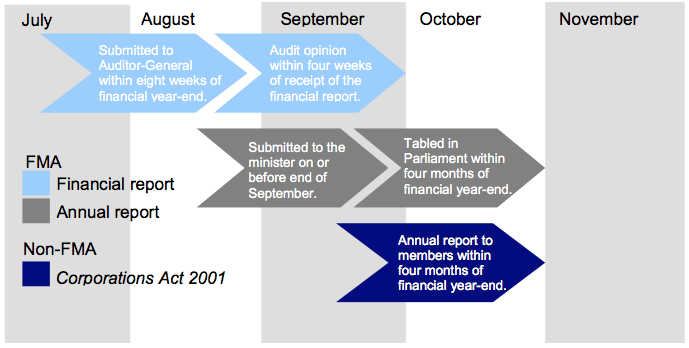
Source: Victorian Auditor-General’s Office.
To achieve timelier reporting more consistent with current community standards, the Premier issued a circular on 10 February 2012 requiring annual reports to be tabled within three months of the end of the financial year. This was consistent with the past two years, but meant that the timeframe for preparing, auditing and tabling financial statements was shorter than shown in Figure 1C. Ministers and government departments work with their portfolio public sector entities with a view to progressively tabling annual reports in Parliament from the end of the second month after the end of the financial year.
1.3 Internal controls
Effective internal controls help entities reliably and cost-effectively meet their objectives; they underpin the reliable, accurate and timely delivery of external and internal reports.
Senior management of an entity is responsible for developing and maintaining adequate systems of internal control to enable:
- preparation of accurate financial records and other information
- timely and reliable external and internal reporting
- appropriate safeguarding of assets
- prevention or detection of errors and other irregularities.
The FMA requires management to implement an effective internal control structure. In establishing effective controls, it should adopt a control framework that has:
- comprehensive policies
- effective management practices
- sound governance and oversight.
In our annual financial audits, we focus on the internal controls relating to financial reporting and assess whether entities have managed the risk that their financial statements will not be complete and accurate. Poor controls diminish management’s ability to achieve strategic objectives and to comply with relevant legislation. They also increase the risk of fraud. Internal control weaknesses identified during our audits are reported to an entity’s management and audit committee.
For portfolio departments, in addition to reviewing general internal controls, a cyclical approach to reviewing internal controls relating to significant annual financial report balances and disclosures is adopted, consistent with Australian Auditing Standards.
This report includes the results of our cyclical review of the appropriation framework, trust funds and risk management.
1.4 Structure of this report
The structure of this report is set out in Figure 1D.
Figure
1D
Report structure
Parts |
Description |
|---|---|
Part 2: Quality of financial reporting |
Comments on the quality of financial reports prepared by portfolio departments and associated entities. |
Part 3: Financial sustainability |
Provides insight into the financial sustainability of the 46 self-funded state entities based on assessment of four indicators that consider both short-term and long-term sustainability. |
Part 4: The appropriation framework |
Comments on aspects of the appropriation framework and the policies, controls, governance and oversight to support the framework. |
Part 5: Trust funds |
Comments on the controls, governance, oversight and reporting of trust funds used to receive and distribute funds for designated purposes. |
Part 6: Risk management |
Reviews risk management practices at the 11 portfolio departments against the Victorian Government Risk Management Framework and international risk management standard. |
Source: Victorian Auditor-General’s Office.
1.5 Audit conduct
The audits were undertaken in accordance with Australian Accounting Standards.
The total cost of preparing and printing this report was $200 000.
2 Quality of financial reporting
At a glance
Background
Independent audit opinions add credibility to financial reports by providing reasonable assurance that the information reported is reliable. This Part covers the results of the 2011–12 audits of the 11 portfolio departments and 193 associated entities that had finalised their financial reports at the time of this report.
Conclusion
No qualified audit opinions were issued for 2011–12. The quality of financial reporting to Parliament is constrained by the narrow definitions within financial reporting directions relating to disclosure of responsible person and executive officer remuneration, and ex gratia payments.
Findings
- In the public sector, the disclosure of responsible persons’ and executive officers’ remuneration is less than is required in the private sector. This limits transparency in a sensitive area of public spending and is not in the public interest.
- Disclosure requirements for ex gratia payments are minimal and allow entities significant discretion in reporting the nature and reasons for ex gratia payments.
Recommendations
The Department of Treasury and Finance should:
- revise Financial Reporting Direction (FRD) 21B to align the disclosure of remuneration of responsible persons and executive officers with Australian Accounting Standards for private sector entities
- revise FRD 11 to mandate meaningful disclosure of the nature, purpose and amount of ex gratia payments made by public sector entities.
2.1 Introduction
This Part comments on the results of the audits of the 11 portfolio departments and 193 associated entities that had finalised their 2011–12 financial reports at the time this report was prepared.
2.2 Conclusion
As no qualified audit opinions were issued, portfolio departments and associated entities are to be commended on the quality of financial reporting achieved in 2011–12. However, the quality of reporting to Parliament would improve if the disclosure of responsible person and executive officer remuneration was aligned with the requirements for private sector bodies under the Australian Accounting Standards, and if more details of the nature and circumstances of ex gratia payments were provided.
2.3 Reliability
2.3.1 Audit opinions
Independent audit opinions add credibility to financial reports by providing assurance that the information is reliable. A clear audit opinion confirms that the financial report has been prepared according to the requirements of relevant accounting standards and legislation.
At the date of preparation of this report, 204 audit opinions on financial reports had been issued, all with clear opinions.
Emphasis of matter
An auditor can draw a reader’s attention to a matter or disclosure in the financial statements that provides important context. This is not a qualification and is known as an ‘emphasis of matter’.
Three entities received an auditor’s report containing an emphasis of matter for 2011–12, compared with five in 2010–11. Figure 2A lists the entities and the reasons for the emphases.
Figure
2A
Opinions with emphasis of matter paragraphs, 2011–12
Entity |
Reason |
|---|---|
Department of Transport and Public Transport Development Authority |
The emphasis of matter drew the reader’s attention to the fact the financial report was a composite report that included the financial results and positions of both entities. |
Metlink Victoria Pty Ltd |
The financial statements were prepared on a basis to reflect the orderly winding up of the company. The emphasis of matter drew the reader’s attention to the fact that the going concern basis was not appropriate for the preparation of the financial statements for the period ended 21 June 2012. |
VicFleet Pty Ltd |
The financial statements were prepared on a basis to reflect the orderly winding up of the company. The emphasis of matter drew the reader’s attention to the fact that the going concern basis was not appropriate for the preparation of the financial statements for the period ending 30 June 2012. |
Source: Victorian Auditor-General’s Office.
Other matter
Where an entity’s auditor has changed, auditing standards allow for the current year’s audit opinion to include an ‘other matter’ paragraph that discloses this to aid users’ understanding of the financial report.
The financial report of Metlink Victoria Pty Ltd for the year ended 30 June 2011 was not audited by the Auditor-General, as the company was not a public body. Therefore, the audit opinion for Metlink Victoria Pty Ltd for 21 June 2012 disclosed this as an ‘other matter’.
2.4 Audits by invitation
Under section 16G of the Audit Act 1994, the Auditor-General can accept an invitation to conduct the financial audit of an entity that is not an ‘authority' under the Act. An entity that does not meet the definition of an authority is not required to have the Auditor‑General conduct its financial audit.
Before accepting such an engagement the Auditor-General must be satisfied that the person or body exists for a public purpose, and that it is practicable and in the public interest for the Auditor-General to conduct the audit.
The Auditor-General conducted financial audits of four entities by invitation in 2011–12:
- Australian Health Practitioner Regulation Agency
- Parliament of Victoria
- Senior Master of the Supreme Court
- VCAMM Limited.
When conducting financial audits under section 16G, the Auditor-General is precluded from considering issues of waste, probity and lack of financial prudence. These considerations are a requirement of all other financial audits conducted by the Auditor‑General, and are a generally expected focus of public sector audit.
For 2011–12, the opinions issued for audits conducted under section 16G show that no consideration was given to matters relating to waste, probity and lack of financial prudence in the conduct of the audits. This made clear to the users that such issues were not considered and, if identified, were not reported to Parliament.
2.5 Disclosure by public sector entities
Portfolio departments and public bodies prepare financial reports in accordance with Australian Accounting Standards and the Financial Management Act 1994 (FMA). While the accounting standards are primarily written for the private sector, the public sector is also required to comply with the standards in most instances. But, in some specific areas the accounting standards explicitly exclude public sector not‑for-profit entities from the requirement to comply.
In such cases, in order to fill the reporting gap and to enhance the consistency of disclosures in the financial reports of public sector entities, the Minister for Finance may elect to issue financial reporting directions (FRD) under the FMA with which public sector not‑for-profit entities must comply.
Where FRDs provide interpretations of terminology narrower than those in the accounting standards, or provide for entities to exercise discretion in what and how much they disclose, the impact is to limit the disclosures made by public sector entities, and is therefore inconsistent with reporting in the public interest.
2.5.1 Transparency of reporting of responsible person and executive officer remuneration
In the case of responsible person and executive officer remuneration, ‘for‑profit’ reporting entities make disclosures in accordance with Australian Accounting Standard AASB 124 Related Party Disclosures (AASB 124). However, not-for-profit public sector entities, including portfolio departments and most public bodies, are not required to apply AASB 124 to their reporting.
AASB 124 requires an entity to disclose all forms of consideration paid, payable or provided by the entity, or on behalf of the entity, in exchange for services rendered to the entity by responsible persons and executive officers. This includes payments of:
- short-term employee benefits
- post-employment benefits such as pensions, retirement benefits, life insurance and medical care
- other long-term employee benefits
- termination benefits
- share-based payments.
FRD 21B Disclosures of Responsible Persons, Executive Officers and other Personnel in the Financial Report (FRD 21B) defines a responsible person's or executive officer’s remuneration as the ‘remuneration package and includes any money, consideration or benefit received or receivable by the person as a responsible person or executive officer’. This narrow definition restricts the disclosure of responsible person and executive officer remuneration to payments included in their remuneration package. Additional payments made outside their remuneration package, such as termination benefits or post-employment benefits, are not required to be disclosed separately in the entity’s financial report.
In 2011–12, compliance with FRD 21B enabled three public sector bodies, including one portfolio department, to disclose limited information only relating to post‑employment benefits paid to former responsible persons. The narrow interpretation in the FRD meant that substantial payments made to these individuals were afforded far less disclosure than would have been required of a for‑profit or private sector entity. The limited disclosure made by the not-for-profit entities, while compliant with the FRD, was not in the public interest.
The Australian Accounting Standards Board is considering expanding the application of AASB 124 to not-for-profit entities, which would address the current reporting and disclosure gap. However, until not-for-profit entities are required to comply with AASB124, or FRD 21B is changed to mirror the requirements of the accounting standard, the potential remains for large payments to be made to responsible persons or executive officers outside the terms of their remuneration packages with limited or no disclosure.
2.5.2 Transparency of reporting of ex gratia payments
During 2011–12 a significant payout was made to an individual leaving the employment of a public sector entity. In this case, as the individual was not the responsible officer of the entity, FRD 21B did not apply. The associated portfolio department deemed the payment to be ex gratia in nature and reported it as such in the department’s financial statements.
Where a public sector entity makes a payment in addition to an entitlement or a legal obligation, that payment is required to be disclosed under FRD 11 Disclosure of Ex‑gratia Payments (FRD 11) as an ex gratia payment in the entity’s financial report. However, the disclosures required under FRD 11 are minimal, and there is limited guidance as to what should be disclosed.
In consequence, disclosure of details and circumstances of ex gratia payments made to individuals, to both Parliament and the public is limited and also results in inconsistent disclosures across the public sector, as entities are able to exercise significant discretion over what they choose to disclose.
Recommendation
-
The Department of Treasury and Finance should:
- revise Financial Reporting Direction (FRD) 21B to align the disclosure of remuneration of responsible persons and executive officers with Australian Accounting Standards for private sector entities
- revise FRD 11 to mandate meaningful disclosure of the nature, purpose and amount of ex gratia payments made by public sector entities.
3 Financial sustainability
At a glance
Background
Financially sustainable entities have the capacity to meet current and future expenditure, and absorb foreseeable changes and risks without significantly changing their revenue and expenditure policies. This Part presents the result of our financial sustainability assessments of the 46 self-funded state entities at 30 June 2012. The assessment is based on four financial sustainability indicators that consider both short-term and long-term sustainability.
Conclusion
The financial sustainability assessment outcome for self-funded entities has not changed from previous years. Self-funded entities still face challenges in generating sufficient cash flows to replace assets over the long term.
Findings
- Thirteen entities were rated as a high financial sustainability risk, and a further 16 were rated as medium risk at 30 June 2012. These results are consistent with the previous financial year.
- The long-term financial ratios of self-financing and capital replacement indicate that entities are not generating enough funds to invest in or maintain their assets.
Recommendation
The implications of the financial sustainability challenges for the accountability of boards, councils and trusts should be reviewed, and a strategy to address them developed.
3.1 Introduction
In this Part we provide insight into the financial sustainability of the 46 self-funded entities that mainly generate their own revenue rather than depend upon government funding.
The 11 portfolio departments and 147 other entities are excluded from the assessment as they are predominantly funded through the State Budget or have developed and already separately reported on sustainability indicators.
The objective of self-funded entities should be to generate a sufficient surplus from operations to meet their financial obligations, and fund asset replacement and new asset acquisitions. The ability of self-funded entities to do this depends largely on their expenditure management and revenue maximisation practices, which is reflected in the composition and rate of change of their operating revenue and expenses.
3.2 Financial sustainability
By analysing four core indicators over a five-year period, we provide insight into the financial sustainability of the self-funded entities. The indicators are:
- underlying result
- liquidity
- self-financing
- capital replacement.
The indicators reflect each entity’s funding and expenditure policies, and indicate whether the policies are sustainable.
Financial sustainability should be viewed from both a short- and long-term perspective. The short-term indicators—in this case, underlying result and liquidity—measure an entity’s ability to maintain a positive operating cash flow and adequate cash holdings, and to generate an operating surplus over time.
The long-term indicators—self-financing and capital replacement—signify whether adequate funding is available, and whether it is being spent on asset renewal to maintain the quality of service delivery, and to help meet community expectations and the demand for services.
Appendix C describes the sustainability indicators and risk assessment criteria we use in this report.
3.3 Financial sustainability risk assessment results
The five-year average financial sustainability results for the 46 self-funded entities are shown by portfolio in Figure 3A.
Figure 3A
Five-year average financial sustainability risk assessments for self-funded entities, at 30 June 2012
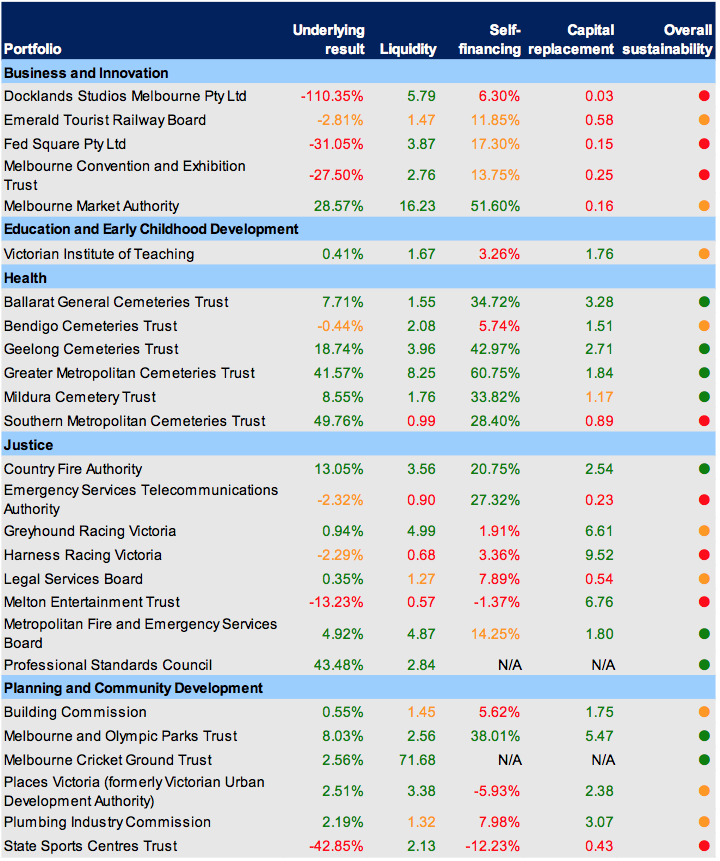
Figure 3A
Five-year average financial sustainability risk assessments for self-funded entities, at 30 June 2012, continued
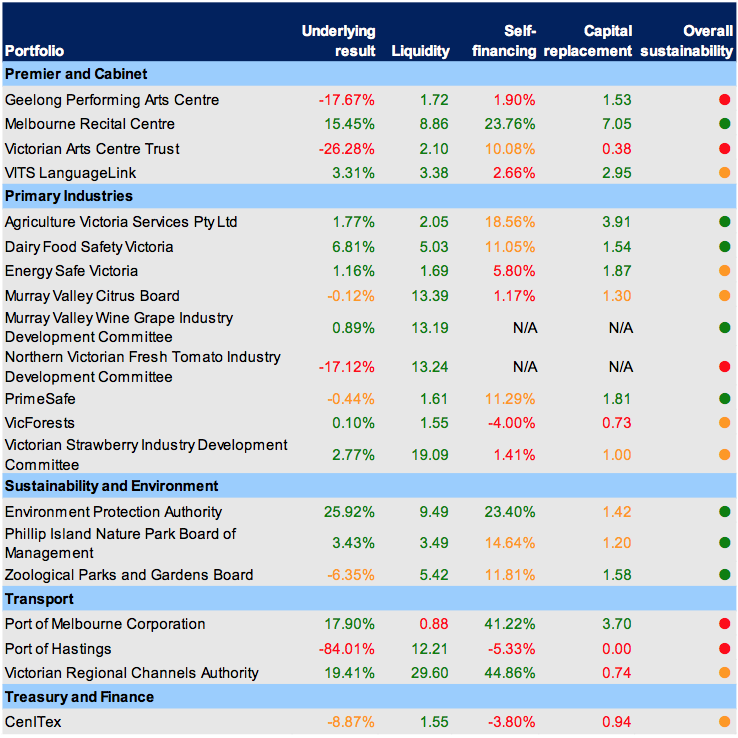
Note: Legend: Red = high risk; Amber = medium risk; Green = low risk.
Source: Victorian Auditor-General’s Office.
Only a third of the 46 entities were assessed as being financially sustainable overall. This was consistent with the five-year average assessments for the last two financial years. As the short-term indicators are generally positive, the overall result suggests that action to address the capital replacement challenge facing most of the 46 entities has been insufficient.
The longer-term ratios are still the most challenging, with the self-financing indicator showing 19 entities generating insufficient cash from operations to fund new assets or asset renewal, with a further 10 at risk. This is consistent with last year, when 23 entities were rated high risk in this aspect, and 13 at medium risk.
The condition of assets may deteriorate in the 14 entities flagged as not investing enough to renew assets, with a further five entities at risk. Failure to maintain assets may affect an entity’s ability to operate in the longer term. These entities may need to rely more on the state for funds to address asset maintenance in the future.
Recommendation
- The implications of the financial sustainability challenges for the accountability of boards, councils and trusts should be reviewed, and a strategy to address them developed.
4 The appropriation framework
At a glance
Background
The general government sector is funded mainly through Parliamentary appropriations. This Part examines key aspects of the appropriation framework and the supporting policies, controls, governance and oversight.
Conclusion
Oversight of the appropriation framework by the Department of Treasury and Finance (DTF) needs strengthening to demonstrate that the purchaser-provider model is delivering its intended outcomes.
Findings
- It is not evident there are adverse consequences for under-delivery or non-delivery of funded outputs. While 99.97 per cent of appropriations were certified, 21.8 per cent of outputs were delivered below the output target, and 6.8per cent of outputs were not delivered.
- Notwithstanding that $1.4 billion of surpluses and unused depreciation funding has been accumulated and is available to provide additional services for the public and infrastructure, portfolio departments—other than the Department of Health—have no plans to use these reserves.
Recommendations
- The Department of Treasury and Finance should review the implementation of the appropriation framework to determine whether acquittal and approval procedures are delivering funding outcomes consistent with its aims.
- Portfolio departments should, in consultation with the Department of Treasury and Finance, include in their long- and short-term plans a clear link between the use of the accumulated state administration unit balances, and the provision of additional services to the public, and infrastructure, consistent with the model.
4.1 Introduction
The principal source of funding for the general government sector comes through appropriations. Most appropriations are disclosed in the State Budget, tabled in Parliament in May each year, and legislated in an annual Appropriation Act. In some cases special appropriations are made to allow portfolio departments to meet payments required by other Acts of Parliament such as the costs of Parliament and the judiciary.
In 2011–12, appropriations to the 11 portfolio departments totalled $39.2 billion.
Portfolio departments access additional funding during the financial year through provisions within the Financial Management Act 1994 (FMA). A summary of the financial framework is shown in Figure 4A.
Figure 4A
Victoria’s financial framework
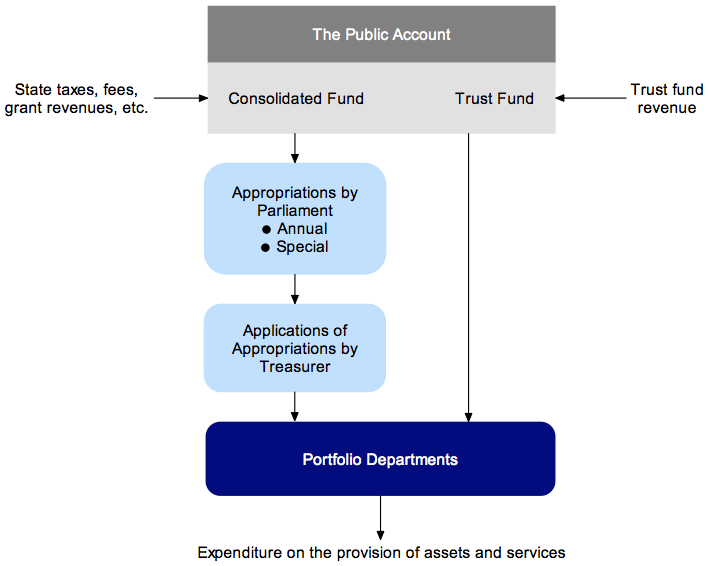
Source: Victorian Auditor-General’s Office.
This Part reports on the operation of key aspects of the appropriation framework and its supporting policies, controls, governance and oversight.
4.2 Conclusion
Oversight of the appropriation framework by the Department of Treasury and Finance (DTF) needs strengthening to demonstrate that the purchaser-provider model is delivering its intended outcomes. We observed that:
- performance against agreed targets and measures is not driving the disbursement of appropriations to portfolio departments
- with the exception of the Department of Health,there are no coherent plans to use the surpluses and unused depreciation funding that has been accumulated by portfolio departments
- there is not a clear definition to guide the making of Treasurer’s advances to meet the provisions of the Appropriation Act.
Portfolio departments account to DTF as to how they have earned their appropriations, as required. However, they need to plan more purposefully for, and use, all funding available to deliver more public services and infrastructure.
4.3 Appropriations
Appropriations to portfolio departments are disbursed under a purchaser‑provider model. Under the model, the Treasurer (the purchaser) purchases an agreed output from a portfolio department (the provider) for an agreed cost (the appropriation). The type and volume of outputs to be delivered in the coming financial year, and their cost, is recorded within the Appropriation Act, and the State Budget.
The purchaser-provider model is an accrual based model; it provides for portfolio departments to have their agreed appropriation revenue certified once they have demonstrated to the Treasurer that the agreed output has been delivered.
4.3.1 Central agency governance and oversight
DTF is the central agency responsible for the governance and oversight of appropriations. DTF’s role includes analysing and assessing the satisfactory delivery of outputs on behalf of the Treasurer. To support DTF in this role, portfolio departments make biannual submissions on the outputs achieved against agreed targets detailed in the State Budget.
At 31 December and 30 June of each financial year to which an appropriation applies, portfolio departments are required to submit to DTF a certification of the outputs delivered during the six-month period. DTF analyses each portfolio department’s submission and makes an assessment of whether, for each output group, the department is:
- on track to deliver the agreed outputs
- delivering outputs, but below the agreed performance levels
- at risk of not delivering the agreed outputs.
Based on the assessment, DTF makes a recommendation for the year ending 30 June to the Treasurer to certify part or all of the appropriation applicable to the period.
We reviewed portfolio department submissions to DTF for the year ending 30 June 2012, and found that DTF’s assessment was that:
- 71.4 per cent of output groups across the 11 portfolio departments were being delivered to target
- 21.8 per cent of output groups were delivered, but below target
- 6.8 per cent of output groups were not delivered.
Where the output groups are not delivered to target, DTF can recommend to the Treasurer action that can be taken to address this and to assist in performance improvement.
Notwithstanding this, DTF recommended to the Treasurer that 99.97 per cent of appropriations be certified. It was recommended that the Department of Transport did not receive the full appropriation requested, with $9.5 million not approved due to issues with metropolitan franchise operator incentive payments. Accordingly, the Treasurer certified 99.97 per cent of the appropriations requested by portfolio departments for the year. The total value awarded was $36.4 billion. Under the purchaser-provider model, portfolio departments should receive their appropriations only when they have delivered the outputs to the standard or quality agreed in the State Budget. By awarding the full amount to portfolio departments, regardless of the outputs achieved, it is not evident the purchaser-provider model is being used to drive effective and efficient delivery of outputs. There is little effective response when agreed outputs are not delivered.
Based on DTF’s assessment of portfolio department submissions for the period to 30 June 2012, $2.4 billion of the $36.4 billion was awarded for outputs where performance indicators were not delivered.
4.3.2 Management practices at portfolio departments
To enable their achievements to be assessed and to determine the level of appropriation to be certified, all portfolio departments provide to DTF:
- a request for appropriation monies representing the value of outputs delivered during the period
- an output performance report detailing achievements against each output target for the period
- significant risks the department faces of not achieving output targets for the remainder of the financial year.
All portfolio departments provided the requested information for both the 30 December 2011 and the 30 June 2012 analysis to DTF in a complete and timely manner. However, the accuracy of the information provided needs to be improved. Errors progressively identified during audit resulted in the Treasurer having to sign the appropriations approval certification for the year three times instead of once.
4.4 The state administration unit
To accurately report the balance of appropriations certified as earned, but which were not spent, in delivering outputs under the purchaser-provider model, portfolio departments record a receivable in their annual financial statements. The receivable is reported as ‘Amounts owing from the Victorian Government’ and is referred to operationally as the state administration unit (SAU).
The balances held in the SAU for each department have three key components, as detailed in Figure 4B.
Figure 4B
Key components of the state administration unit
|
Component |
Description |
|---|---|
|
Surpluses earned from the provision of outputs |
Financial surpluses accruing to departments due to outputs being delivered for a lower cost than the revenue appropriated from the Consolidated Fund. Surpluses can only be used to fund additional initiatives with the Treasurer’s prior approval. |
|
Depreciation funding not yet spent on assets |
Appropriations received, equivalent to actual depreciation expenses incurred by departments in delivering outputs, but not yet spent on asset replacement and/or acquisition. |
|
Appropriation accruals |
Appropriation not drawn down yet to pay creditors, employee entitlements and other amounts payable by departments. |
Source: Victorian Auditor-General's Office based on Budget and Financial Management Guidelines, Department of Treasury and Finance (2007).
4.4.1 Funds held in the state administration unit
The total value of the SAU receivable by portfolio departments increased by 63.1 per cent over the last five financial years, and has increased year-on-year during that period. At 30 June 2012, the 11 portfolio departments reported a total of $3.7 billion as SAU receivables in their financial statements. The balance held by the 11 portfolio departments for each of the past five years is shown in Figure 4C.
Figure 4C
Amounts owing from the Victorian Government to portfolio departments at 30 June
|
Department |
2008 |
2009 |
2010 |
2011 |
2012 |
|---|---|---|---|---|---|
|
Business and Innovation |
68.9 |
87.2 |
106.9 |
72.6 |
84.7 |
|
Education and Early Childhood Development |
706.6 |
789.0 |
895.5 |
1 120.3 |
1 099.5 |
|
Health |
N/A |
N/A |
379.4 |
696.0 |
925.9 |
|
Human Services |
333.9 |
318.5 |
92.9 |
176.9 |
213.7 |
|
Justice |
225.0 |
248.9 |
250.8 |
237.4 |
266.9 |
|
Planning and Community Development |
72.0 |
60.3 |
55.9 |
61.7 |
49.1 |
|
Premier and Cabinet |
50.5 |
84.0 |
89.1 |
93.7 |
121.5 |
|
Primary Industries |
105.1 |
105.0 |
119.7 |
97.6 |
86.6 |
|
Sustainability and Environment |
184.9 |
271.5 |
190.6 |
172.9 |
158.2 |
|
Transport |
443.4 |
438.9 |
544.0 |
472.2 |
610.8 |
|
Treasury and Finance |
90.1 |
87.7 |
104.5 |
96.0 |
102.7 |
|
Total |
2 280.4 |
2 491.0 |
2 829.3 |
3 297.3 |
3 719.6 |
Note: The Department of Health was formed in August 2008 when its functions were moved out of the Department of Human Services.
Source: Victorian Auditor-General’s Office.
4.4.2 Management practices at portfolio departments
As at 30 June 2012, $2.3 billion of the $3.7 billion SAU receivable (62.2 per cent) related to accruals such as employee entitlements and payables. These monies are committed to be spent when payments to the creditors to which they relate are required. Portfolio departments have little discretion over the use of these amounts.
The remaining $1.4 billion SAU receivable is available to portfolio departments with the approval of the Treasurer. Under the purchaser-provider model, portfolio departments that achieve efficiencies and deliver surpluses may apply to the Treasurer to use the money to deliver additional public services and infrastructure. Almost half of the $1.4 billion ($668 million) was held by the Department of Health (DH). DH plans to use these funds for the health sector capital program over the next few years, subject to government approval in future state budgets. However, none of the 10 remaining portfolio departments had plans to use the remainder of their SAU funds.
Approval processes
Line management in portfolio departments stated that a key impediment to using the SAU receivables, and therefore planning for their use, is that the money can only be spent with the Treasurer’s approval.
The FMA provides for comprehensive checks so that portfolio departments have access to SAU receivables only when the money is legally available to be spent. This is important, and controls the need to provide adequate assurance to Parliament, as this money is spent outside the current year’s Appropriation Act. If not adequately controlled, the funds could be spent for purposes inconsistent with government policy outcomes or without proper accountability or transparency.
However, oversight arrangements should not hinder portfolio departments from planning and delivering additional public services or infrastructure for legitimate purposes, as the framework intends.
4.4.3 Governance and oversight
The government has an obligation to pay the SAU receivables to portfolio departments. It also has a responsibility to maintain effective oversight of SAU balances. This role is undertaken on its behalf by DTF.
DTF receives quarterly SAU reconciliations from each portfolio department and confirms that it agrees with information held centrally. Responsibility for the accuracy of the quarterly reconciliations rests with chief finance officers of portfolio departments.
The oversight exercised by DTF is sufficient to give comfort on the accuracy of the SAU figures. While there is a budget process in place that considers the long- and short-term plans of the portfolio departments, this does not provide a clear link between expenditure of the SAU balance and the provision of additional services and infrastructure. This reduces DTF’s ability to plan the cash flow it requires to have available at any time to meet requests for funds by portfolio departments.
Portfolio departments regularly review their individual SAU balances to identify and correct errors, and to maintain oversight of the receivable. We observed that this occurred in each portfolio department at least quarterly.
Capping of the SAU
Our 2003 report, Parliamentary control and management of appropriations, recommended that the SAU be capped to manage its growth and the corresponding drawdown of cash from the Consolidated Fund.
A cap has not been introduced and the SAU receivable has continued to grow. Figure 4D breaks down the growth of the SAU balance across the three key components over the past five years.
Figure 4D
State administration unit receivable held by portfolio departments at 30 June

Source: Victorian Auditor-General’s Office.
The largest areas of growth are in the components that can be used by portfolio departments to deliver additional services or infrastructure—depreciation funding not yet spent, and the balance of surpluses earned. Given the trend to date, unless action is taken to use these funds, or to establish a cap, the growth in the SAU balances will likely continue.
This growth poses a problem for government, as its obligation to service the receivable is also growing. At 30 June 2012, the SAU payable by the government to portfolio departments was $3.7 billion, compared to a general government sector cash balance of $433 million held in the Consolidated Fund. This shows that there was not enough money in the bank to fund the SAU payable at 30 June 2012 if all portfolio departments were to seek their money.
4.5 Treasurer’s advances
Under the Appropriation Act, the Treasurer has available to him a pool of funds to meet urgent expense claims. This is because appropriations to portfolio departments and entities are set in the budget, well in advance of the financial year and unforeseen circumstances that require additional expenditure inevitably arise during each year.
The Appropriation Act 2011–12 sets aside $779 million as an ‘Advance to Treasurer to enable Treasurer to meet urgent claims that may arise before Parliamentary sanction is obtained, which will afterwards be submitted for Parliamentary authority’ during the financial year. These payments are commonly referred to as a Treasurer’s advance (TA). A disclosure of the money actually provided through these advances was included in the Annual Financial Report of the State of Victoria, 2011–12, provided to Parliament on 15 October 2012.
4.5.1 The value of Treasurer’s advances
The number and value of TAs varies year-on-year because, by their nature, they are for urgent items not foreseen in the budget. In 2011–12, the Treasurer approved 48 TAs totalling $776 million.
Figure 4E shows the aggregate of TAs awarded across the 11 portfolio departments over each of the past five years.
Figure 4E
Value of Treasurer’s advances approved, 2007–08 to 2011–12
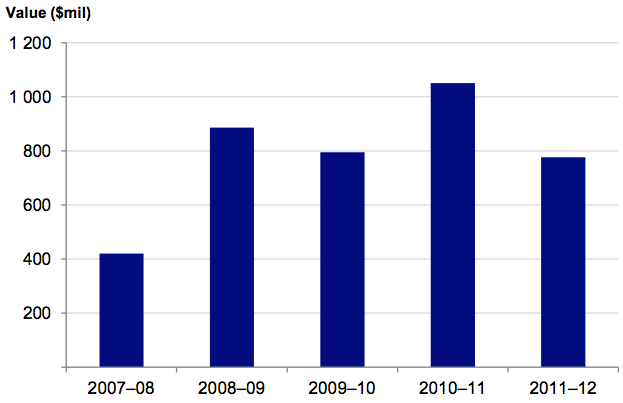
Source: Victorian Auditor-General’s Office.
The value of TAs awarded peaked in 2008–09 and 2010–11. This coincided with two natural disaster events:
- the bushfires in February 2009
- the floods in September 2010 and January/February 2011.
The 2010–11 TA value also includes money for the implementation of the recommendations of the Victorian Bushfires Royal Commission.
4.5.2 Central agency governance and oversight
DTF receives TA requests from portfolio departments and is responsible for analysing the validity of the request, and making a recommendation to the Treasurer.
To properly assess the validity of a TA request, the definition of ‘urgent’ should be clear and a set of criteria relevant to the purpose for TAs developed and documented. This would provide greater assurance that funds allocated meet the purpose of TAs established under the Appropriation Act.
In practice, there is no definition of ‘urgent’. The criterion that DTF applies to TA requests is that applications should only be made ‘where a department has exhausted, or is close to exhausting, all available legal sources of funding’.
We analysed the nature of expenditure approved under TAs over the past five years and the results are shown in Figure 4F.
Figure 4F
Treasurer’s advances per expenditure type as a percentage of all Treasurer’s advances, 2007–08 to 2011–12
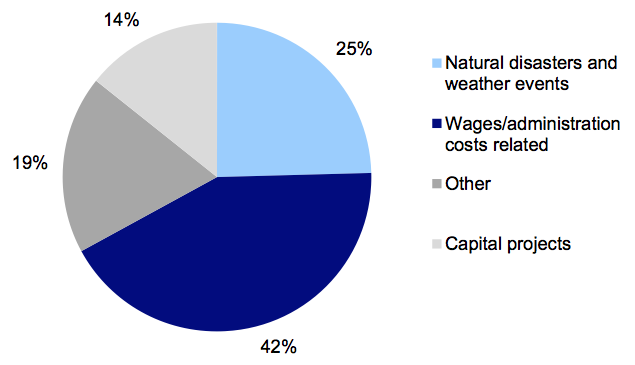
Source: Victorian Auditor-General’s Office.
Figure 4F shows that 25 per cent of the value of TAs was for expenditure relating to natural disasters. Based on the definition of ‘urgent’ as something that calls for immediate attention this would clearly be considered urgent expenditure and therefore fit the intention of the Appropriation Act.
However, 42 per cent of TAs went to wages, depreciation, administration costs and other expenditure within portfolio departments. A further 14 per cent related to capital projects. These expenses do not clearly present as ‘urgent’. It is not evident why they were unforeseen, or were not met from appropriated recurrent or capital funding or specific project funding.
An example of the way TAs have been used to provide non-urgent funding to one portfolio department is shown in Figure 4G.
Figure 4G
Case study – Education sector enrolment-based funding
Enrolment-based funding is a funding component for Victoria’s Tertiary and Further Education Institutes (TAFEs) and adult and community further education, schools and kindergartens. It is calculated each financial year based on the number of enrolled students in such education institutions. Variations in pupil numbers between schools and school years make the exact amount of funding required difficult to predict.
Since 2008–09, enrolment-based funding provided for these institutions to the Department of Education and Early Childhood Development (DEECD) through appropriation has been supplemented through TAs to cover the difference between the amount appropriated and the actual funding required. The value of TAs awarded by type of educational institution for each year is shown below.
|
Educational institution |
2008–09 |
2009–10 |
2010–11 |
2011–12 |
|---|---|---|---|---|
|
Kindergartens |
8.0 |
6.0 |
0.5 |
10.5 |
|
Schools |
– |
35.7 |
38.9 |
51.7 |
|
TAFEs, adult, community and further education |
– |
– |
150.0 |
459.8 |
|
Total |
8.0 |
41.7 |
189.4 |
522.0 |
Enrolment-based funding is an annual expenditure item for DEECD. It should be capable of being forecast with reasonable accuracy. Where the forecast falls short, an agreement between DEECD and DTF allows for the difference to be made up by TAs or an alternative funding source.
The year on year requirement to source additional funds through TAs raises concerns with the method for calculating the budget figures.
In using TAs to make up the funding shortfall, TAs are being used as an additional funding source, not for urgent expenditure.
Source: Victorian Auditor-General’s Office.
This example and our analysis of other documentation suggests that TAs are used by portfolio departments as an alternative source of funding.
While we acknowledge that portfolio departments may experience difficulty and inconvenience in continuing their day-to-day operations when funding is short, it is not evident that the imminent exhaustion of a department’s appropriation or available funding, or the inability to predict funding needs accurately, constitutes ‘urgency’. Providing funding for the normal operations of a portfolio department over and above its annual or special appropriations could be seen to reward ineffective resource management and poor performance. Furthermore, awarding TAs for non‑urgent items means that the level of funds available for the state to respond to genuine urgent events in a timely manner is reduced.
The Treasurer, and DTF as the central agency, should work with portfolio departments so that only TA requests which meet the generally accepted definition of urgent are approved.
Recommendations
- The Department of Treasury and Finance should review the implementation of the appropriation framework to determine whether acquittal and approval procedures are delivering funding outcomes consistent with its aims.
- Portfolio departments should, in consultation with the Department of Treasury and Finance, include in their long- and short-term plans a clear link between the use of the accumulated state administration unit balances, and the provision of additional services to the public, and infrastructure, consistent with the model.
- The Department of Treasury and Finance should adopt a definition of urgent that would mean that Treasurer’s advances are awarded only for purposes consistent with the Appropriation Act.
5 Trust funds
At a glance
Background
Trust funds are discrete accounts that receive and distribute money for designated purposes. At 30 June 2012, the state had 111 trust funds that collectively held $2.7 billion. This Part reports on our review of key aspects of the controls, governance, oversight and reporting of trust funds.
Conclusion
The number of trusts, and the total money held in each, is growing. However, there is minimal disclosure, and a lack of policies and guidelines to support their use. No recent assessments have been performed to as to whether trust funds are being used as intended and that they are aligned with government objectives.
Findings
- There is evidence that Treasury trust funds are not being used as intended.
- There is no evidence that the working trust operated by the Department of Business and Innovation is legally established.
- With one exception, portfolio departments and the Department of Treasury and Finance (on behalf of the Minister for Finance), could not demonstrate they periodically reviewed the nature and purpose of each trust fund to confirm its relevance and alignment with the strategic objectives of government.
- The purpose for each trust, and the amounts paid into and out of it annually, is not publicly reported.
Recommendations
- The Department of Treasury and Finance should:
- review every treasury trust fund to determine whether it is being used as intended, and address noncompliance as necessary
- review its trust fund guidelines for consistency with better practice.
- The Department of Business and Innovation should confirm its legal authority to operate its working trust or close the trust.
5.1 Introduction
Trust funds are discrete accounts established to record the receipt and disbursement of state funds for specified purposes. They can be set up under their own legislation or by the Minister for Finance under the Financial Management Act 1994 (FMA). At that stage the trust’s purpose is established, and it is specified how its funds can be spent.
Each trust fund is assigned to one of the 11 portfolio departments. The portfolio department is responsible for reporting the balance of the trust within its audited financial statements. A high level report of all trust funds is also included in the Annual Financial Report of the State of Victoria prepared by the Department of Treasury and Finance (DTF) and tabled in the Parliament in October each year.
This Part reports on our review of key aspects of trust fund policies, controls and governance in place at portfolio departments and within DTF, the central oversight entity.
5.2 Conclusion
Portfolio departments lacked policies for controlling and monitoring trust funds, and the supporting guidelines issued by DTF, the central agency, were not current.
The number of trusts, and total money held in each, is growing year on year; however, DTF has not recently assessed whether trusts are being used as intended and are aligned with the priorities and strategic objectives of government.
Notwithstanding the significant funds held, and which flow in and out of the state’s 111 trust accounts annually, there is minimal disclosure to Parliament or the public about them.
5.3 Trust fund balances
As at 30 June 2012, the state had 111 trust funds with a combined value of $2.7 billion. A summary of where the trusts are held is shown by portfolio department in Figure 5A.
Figure 5A
Trust funds held by portfolio departments as at 30 June 2012
|
Department |
Number |
Value |
|---|---|---|
|
Business and Innovation |
6 |
23.5 |
|
Education and Early Childhood Development |
6 |
119.0 |
|
Health |
7 |
73.4 |
|
Human Services |
6 |
26.0 |
|
Justice |
19 |
495.8 |
|
Planning and Community Development |
12 |
323.2 |
|
Premier and Cabinet |
7 |
11.9 |
|
Primary Industries |
12 |
91.8 |
|
Sustainability and Environment |
20 |
260.7 |
|
Transport |
5 |
768.0 |
|
Treasury and Finance |
11 |
534.4 |
|
Total |
111 |
2 727.7 |
Source: Victorian Auditor-General’s Office.
The value and number of trust funds has grown over the past five years. The value increased by 59 per cent, from $1.7 billion in 2008 to $2.7 billion in 2012. Over the same period the number of trust funds increased from 100 to 111. These are set out in Figure 5B.
Figure 5B
Value and number of trust funds held by portfolio departments 2007–08 to 2011–12
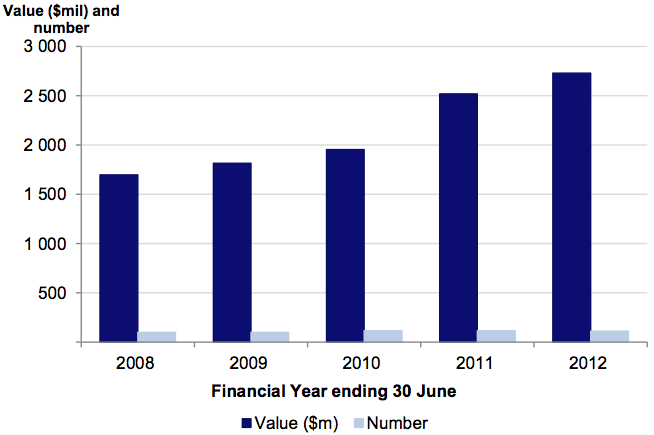
Source: Victorian Auditor-General’s Office.
The key drivers behind increases in the value of trust funds include:
- an increase in the amounts held for natural disaster relief from $6.4 million in 2008 to $462.6 million in 2012 due to the 2009 bushfires and 2010 floods
- growth in the Department of Transport’s Better Roads Trust Fund from $69.7million in 2008 to $476.2 million in 2012 due to more money being received from state appropriations for road projects including maintenance and vehicle registration. The balance of the trust fluctuates year on year in part due to the timing of Commonwealth funding for joint projects.
- an increase in amounts held in treasury trust funds at portfolio departments. These are discussed in further detail below.
5.3.1 Treasury trusts
Each portfolio department can operate a treasury trust, created under the FMA, to capture and record unclaimed and unidentified money. Across the 11 portfolio departments there were 13 treasury trust funds at 30 June 2012. Combined, they held $253 million, up from $152.9 million five years ago.
In practice, treasury trust funds hold more than unclaimed and unidentified monies and are no longer being used for the purpose for which they were intended. They were holding monies that would normally be paid into the Consolidated Fund and available for appropriation. In particular, there were examples where unspent grants and revenue from asset sales were held in treasury trust funds. In these cases decisions around future spending could be made at the discretion of the portfolio department rather than through the established appropriation process. This is inconsistent with the FMA and is a missed opportunity for the state to make strategic decisions around allocations and the most appropriate use of funds for the state as a whole.
We expected that DTF, on behalf of the Minister for Finance, would monitor the amounts held in treasury trusts and, consequently, would have identified the trend of increasing balances and transactions. If monitoring was occurring the trend should have prompted further investigation. However, there was no evidence of such monitoring or that any action had been taken to address the inappropriate use of treasury trusts.
5.3.2 Working trust funds
The FMA allows a portfolio department to establish a working trust fund into which agreed revenue received from delivering outputs can be placed. The Minister for Finance and the minister responsible for the portfolio department must agree on:
- the purpose and outputs for which money can be spent
- the conditions attached to the trust.
At 30 June 2012, five working trusts were in operation. The most significant was a Department of Business and Innovation (DBI) trust with a balance of $21.8 million. DBI was unable to produce evidence:
- to prove that the trust was legally established
- of an agreement between the Minister for Finance and the portfolio minister on the purpose, outputs and conditions attached to the trust.
Further, DTF had no record of DBI receiving authority to operate a working trust.
The trust is being used by DBI to set aside unspent appropriations on projects and programs which are incomplete or ongoing. This use is not consistent with the intended purpose of working trusts. Where appropriation funding remains unspent at the end of a financial year, there is provision under the FMA to carry it forward, subject to approval from the Treasurer. This is the appropriate way for DBI to manage its unspent appropriations and to increase transparency over the funds set aside.
5.4 Policies
Responsibility for managing individual trust funds rests with the respective portfolio departments. Portfolio departments should have approved policies and procedures to control and manage the funds held within, and moving in and out of, trust funds.
The departments of Planning and Community Development, Primary Industries and Sustainability and Environment (DSE) had tailored policies and guidelines that had been approved by their secretaries. The Department of Education and Early Childhood Development had a policy in draft.
The remaining seven portfolio departments did not have policies and relied on guidelines issued by DTF in 2007 for managing their trust funds. While the guidelines provide some foundation for portfolio departments, they have not been revised for five years and may not reflect better practice. They also warrant tailoring to address individual departmental circumstances.
5.5 Management practices
Portfolio departments play a pivotal role in collecting and recording details of all money paid into and moved out of their trust funds. They should also have controls so that all money paid out is used for purposes consistent with the designated purpose of their trusts.
A review of a sample of 129 special purpose trust fund receipts and 140 trust fund payments was conducted across the 11 portfolio departments during 2011–12. All payments tested had been made in accordance with the trust fund legislation or designated purpose. Furthermore, no exceptions were noted with the receipts tested.
5.6 Governance and oversight
As the objectives and goals of government change, it is prudent for portfolio departments and the Minister for Finance to review trust funds to determine whether they remain relevant and aligned with government objectives. At the same time, trust funds with stagnant balances should be reviewed, as this may indicate that a trust fund is no longer active or required, and the money should be transferred to the Consolidated Fund.
DTF, on behalf of the Minister for Finance, could not demonstrate that regular reviews of trust funds were undertaken to determine alignment with government objectives. Similarly, with one exception, portfolio departments had not routinely documented whether they had revisited the nature and purpose of their trust funds.
As an example, DSE operates a plant and machinery trust fund. The fund was established in 1987 to collect revenue from hiring out of equipment and to use that money to replace hired equipment. The trust had a balance of $46.6 million at 30 June 2012, up from $1.2 million five years ago. DSE could not provide plans about how the money in the trust is to be spent, whether it is still required for asset replacement, why the accumulation of funds has continued, or why such a large amount has been accumulated.
Notwithstanding the lack of reviews, we did not identify any stagnant trust funds. Of the 111 trust funds at 30 June 2012, only six had had the same balance for each of the past five financial years. A further 16 had the same balance for two consecutive financial years. However, each of the 22 had received income and made payments in each of the five financial years.
5.7 Reporting
Trust funds fall into two categories:
- Controlled trust funds: trust funds where the responsible portfolio department can make decisions about how the funds are used.
- Administered trust funds: trust funds for which decisions about how the funds are used are made outside the portfolio department. The department’s responsibility for these trust funds is limited to processing the trust’s receipts and payments.
Portfolio departments are required to report on both categories of trust funds within their audited financial statements. Controlled trust funds are reported in the operating statement and balance sheet of the portfolio department, and administered trust funds are reported as a year-end balance in the notes to a department’s financial statements.
At a minimum, portfolio departments are encouraged, through the DTF‑issued model financial statements, to report the following information about their trust funds:
- the name of the trust fund
- the closing balance at 30 June for the current and prior year
- details of any trust funds closed or opened during the current financial year.
Complete and accurate reporting of the nature and purpose of the trust fund, the transaction flows in and out, and balance at the end of the financial year can provide useful information to users of the financial statements. Currently, there is no requirement to report:
- the value of receipts received by each trust fund in the current financial year
- the value of payments made by each trust fund in the current financial year
- a description of the purpose of each trust fund.
The only portfolio department that provided some of the above listed additional information at 30 June 2012 was DBI. It detailed the receipts and payments made in the current financial year for each of its trust funds.
We were unable to ascertain the value of transactions handled through the remaining 105 trust funds during 2011–12. However, given the large amount of money held at 30 June 2012, we expect the quantum of inflows and outflows would be significant.
As well as a lack of transparency over the payments into and out of trust funds, there is a lack of transparency around the nature and purpose of each trust, with only the name of a trust fund currently disclosed. In many instances the name of the fund provides little information to the reader of the accounts. For example, the DSE operates a Project Trust Fund. Its balance was $142.1 million at 30 June 2012. The name of the fund and the balance are reported in the audited financial statements of the portfolio department, however, this provides no meaningful indication to a reader about what project or projects the money is intended to fund.
Recommendations
- The Department of Treasury and Finance should:
- review every treasury trust fund to determine whether it is being used as intended, and address noncompliance as necessary
- review its trust fund guidelines for consistency with better practice.
- The Department of Business and Innovation should confirm its legal authority to operate its working trust or close the trust.
- The Department of Treasury and Finance and portfolio departments should periodically review the purpose and currency of trusts to assess alignment with changing government objectives.
- To better inform users of financial statements and provide greater transparency to the Parliament and the public, reporting requirements should be enhanced to require annual disclosure of the nature and purpose of each trust and the amount of its revenue and expenditure.
6 Risk management
At a glance
Background
Effective risk management is an important element of governance. In this Part we comment on risk management practices at the 11 portfolio departments against the Victorian Government Risk Management Framework and the international risk management standard.
Conclusion
Risk management practices across the 11 portfolio departments are adequate and there is general compliance with frameworks and standards. There are nevertheless opportunities to strengthen the risk management policies and training at portfolio departments.
Findings
- All portfolio departments had comprehensive policies for risk management, however, the currency of their policies could be improved.
- Portfolio departments allocate sufficient resources to risk management, although theknowledge and understanding across the departments could be strengthened through regular, tailored training.
- An annual attestation on compliance with therisk management standard has been required since 2007. Despite the passage of five years, three portfolio departments still attest that they are developing or progressing their risk management controls and frameworks.
Recommendations
That portfolio departments should:
- review and approve risk management policies annually
- conduct regular tailored training for all staff on risk identification and management
- act decisively to address areas of noncompliance with the risk management standard.
6.1 Introduction
Risk management is an important component of governance. Each year, the public sector commits significant resources to delivering services and infrastructure for the community, and employs thousands of staff to whom it has obligations as an employer. Because public bodies are required to reliably deliver services and infrastructure and fulfil their duties as employers, they need to recognise risk and manage it well.
In this Part we report on our review of the risk management frameworks of the 11 portfolio departments, focusing on the policies, governance, oversight and management practices in place.
6.2 Conclusion
Overall, the risk management frameworks at the 11 portfolio departments are adequate. All portfolio departments had in place most of the key elements of an effective risk management framework. There were nevertheless opportunities to strengthen risk management by regularly reviewing and updating policies and providing tailored training.
6.3 Risk management framework
The Financial Management Act 1994 requires all portfolio departments to comply with the Victorian Government Risk Management Framework. The framework provides general principles, outlines roles and responsibilities, and promotes best practice for risk management. The framework points to the risk management standard AS/NZ ISO 31000:2009 to provide further guidance to portfolio departments.
Adopting the principles in the Victorian Government Risk Management Framework and the standard, Figure 6A outlines the key elements of an effective risk management framework.
Figure 6A
Key elements of an effective risk management framework
|
Component |
Key elements |
|---|---|
|
Policy |
|
|
Management practices |
|
|
Governance and oversight |
|
Source: Victorian Auditor-General's Office based on the Victorian Government Risk Management Framework and Risk Management Standard ISO AS/NZ 31000:2009.
6.4 Policies
Effective risk management requires portfolio departments to identify events that might prevent them meeting their strategic and operational objectives, and to act to mitigate those risks. Better practice is that an organisation has a risk management policy in place. It was positive that all portfolio departments had risk management policies.
The policies were assessed against the elements outlined in Figure 6A and the following elements of better practice were noted:
- All portfolio departments had documented their processes for identifying and analysing risks.
- All portfolio departments had clearly documented the risk management responsibilities and accountabilities within their organisation.
The policies of two portfolio departments did not reference the risk management standard AS/NZ 31000:2009. The currency of risk policies could be improved in six of 11 portfolio departments that had not reviewed their policies within the last year.
Risk registers can be effective tools for collating and tracking identified risks and their related mitigation strategies. All portfolio departments used risk registers that were regularly updated and included risk mitigation strategies, controls or treatment plans. The risk registers in three portfolio departments could more clearly link identified risks to the entity’s strategic objectives to give comfort that risks to achieving the objectives have been identified and treatment plans developed.
6.5 Management practices
Risk management is a responsibility of all staff and should be an element of an organisation’s culture. Risk management should be part of, not separate from, day‑to‑day business processes and practice.
In all portfolio departments, executive management was involved in identifying and assessing risk. How and when engagement occurred varied across portfolio departments, however each entity’s processes were reasonable and reflected their individual needs.
The same was true for the methods used to track emerging risks and revise existing risks. Each portfolio department had an appropriate process relative to its needs, although it is worth noting that there were a number of variations to the process. In most portfolio departments, the accountability for identifying and reviewing risks rested with operational groups and the managers responsible for each group.
Portfolio departments should have adequate resources to manage risk and well‑defined responsibilities for risk management. Each of the 11 portfolio departments allocated sufficient resources for risk management activities.
The knowledge and understanding of risk management within portfolio departments could be strengthened in the seven portfolio departments that had not provided tailored risk management training to staff at the time of our review.
Risk management should be an important consideration in a portfolio department’s strategic planning activities. However, six portfolio departments had not made risk management an explicit part of their strategic and business planning.
6.5.1 Interagency risks
Risk to public sector service delivery and resource management does not always fit into the responsibilities of any one department or portfolio. Accordingly, portfolio departments need to identify interagency risks that could have an impact on the effective delivery of outputs or consider the possible effect the risks they have identified could have on other entities.
The Victorian Government Risk Management Framework contends that most interagency risks will be managed informally. It was therefore positive that six portfolio departments had formal methods or mechanisms for sharing information with other portfolio agencies. This provides a greater opportunity to achieve linked objectives and jointly manage risk to maximise outcomes.
6.6 Governance and oversight
The terms of reference for all 11 portfolio department audit committees included responsibility for monitoring risk management. Duties performed by audit committees generally included:
- review and endorsement of the risk management framework
- review and endorsement of the risk profile
- review of regular reports prepared by management (at least biannually)
- oversight of the internal audit plan.
An effective internal audit plan should address areas of risk and align with a portfolio department’s risk register. This occurred in all portfolio departments. We observed that all internal audit plans were linked to risk, thereby providing comfort that internal audit reviews were appropriately aimed at areas of risk.
Most commonly, management reported quarterly to the audit committee on the risk management framework and any updates to the risk register.
The audit committee should act in an advisory capacity and provide an independent review of the risk management framework to the secretary. We found the frequency and type of reporting from the audit committee to the secretary varied between portfolio departments. Nevertheless, the secretary received a verbal brief, audit committee minutes, a summary report, or a combination of these in all portfolio departments.
The Victorian Government Risk Management Framework requires public sector agency heads to provide an attestation that their risk identification and management plan is consistent with the requirements of AS/NZS ISO 31000:2009. A responsible body or audit committee is required to verify this attestation.
Since July 2007, portfolio departments have been required to attest, in their annual reports, that their risk management function is consistent with the risk management standard. The 2011–12 annual reports of all 11 portfolio departments carried an attestation and in all cases it was supported by the audit committee.
Notwithstanding that secretaries have been required to provide attestations for five years, the secretaries of the Departments of Health, Justice and Premier and Cabinet attested that their risk management controls and framework were developing or progressively being implemented.
All portfolio departments should be at a level of proficiency that achieves full compliance with the international standard on risk management and enables attestation to that fact.
Recommendation
- That portfolio departments should:
- review and approve their risk management policies annually
- conduct regular tailored training for all staff on risk identification and management
- act decisively to address areas of noncompliance with the risk management standard.
Appendix A. VAGO reports on the results of audits
Figure A1
VAGO reports on the results of the 2011–12 financial audits
Report |
Description |
|---|---|
Auditor-General’s Report on the Annual Financial Report of the State of Victoria, 2011–12 |
The report provided the result of the audit of the state’s annual financial report. It addresses the quality and timeliness of financial reporting, explains significant financial results for the state and financial implications of significant projects and developments that occurred during 2011–12 and subsequent to year end. Tabled in Parliament on 14 November 2012 |
Public Hospitals: Results of the 2011–12 Audits |
The report provided the results of the audits of approximately 110 entities, addressing the timeliness of their financial reporting, their financial sustainability, a review of the operations of their audit committees, aspects of how they manage capital projects and an analysis of self-generated hospital revenue. Tabled in Parliament on 14 November 2012 |
Water Entities: Results of the 2011–12 Audits |
The report provided the results of the audits of 20 water entities, addressing the timeliness of their financial and performance reporting, their financial sustainability, aspects of how they manage risks, and an analysis of water tariff revenue. Tabled in Parliament on 14 November 2012 |
Portfolio Departments and Associated Entities: Results of the 2011–12 Audits This report |
The report provides the results of the annual financial statement audits of approximately 210 entities. The report will comment on the timeliness of their financial reporting, financial sustainability and reporting developments, and aspects of how the departments manage risks, appropriations and trust funds. Tabled in Parliament on 28 November 2012 |
Local Government: Results of the 2011–12 Audits |
The report provides the results of the audits of approximately 100 entities in the local government sector. The report will address the timeliness of their financial and performance reporting, their financial sustainability, and aspects of how they manage their budget processes and outsourced arrangements. Tabled in Parliament on 28 November 2012 |
Tertiary Education and Other Entities: Results of the 2012 Audits |
The report will provide the results of the annual financial audits of approximately 120 entities with a financial year other than 30 June 2012. The report will address the timeliness of their financial and performance reporting, their financial sustainability, a review of their utilisation of internal audit, and credit card security controls and usage. Proposed to be tabled in Parliament in May 2013. |
Source: Victorian Auditor-General’s Office.
Appendix B. Glossary
Accountability
Responsibility of public sector entities to achieve their objectives, with regard to reliability of financial reporting, effectiveness and efficiency of operations, compliance with applicable laws, and reporting to interested parties.
Amortisation
The systematic allocation of an intangible asset’s capital value as an expense over its expected useful life to take account of normal usage, obsolescence, or the passage of time.
Asset
A resource controlled by an entity as a result of past events, and from which future economic benefits are expected to flow to the entity.
Audit Act 1994
An Act of the State of Victoria that establishes:
- the operating powers and responsibilities of the Auditor-General
- the operation of his office, the Victorian Auditor-General’s Office (VAGO)
- the nature and scope of audits conducted by VAGO
- the relationship of the Auditor-General with the Public Accounts and Estimates Committee as the representative body of Parliament
- the Auditor-General’s accountability to Parliament for discharge of the position’s responsibilities.
Auditor’s opinion
Written expression within a specified framework indicating the auditor’s overall conclusion on the financial (and performance) reports based on audit evidence obtained.
Capital expenditure
Amount capitalised to the balance sheet for contributions by a public sector entity to major assets owned by the entity, including expenditure on:
- capital renewal of existing assets that returns the service potential or the life of the asset to that which it had originally
- capital expansion which extends an existing asset at the same standard to a new group of users.
Clear audit opinion – financial report
A positive written expression provided when the financial report has been prepared that presents fairly the transactions and balances for the reporting period in accordance with the requirements of the relevant legislation and Australian Accounting Standards.
Also referred to as an unqualified audit opinion.
Consolidated Fund
The Consolidated Fund represents the government’s main operating account. All money forming part of the Consolidated Revenue under the Constitution Act 1975 and all other money raised by or on behalf of or received by the state is required to be paid into the Consolidated Fund.
Corporations Act 2001
An Act of the Commonwealth of Australia that sets out the laws dealing with business entities in Australia at federal and interstate levels. The Act focuses mainly on companies, although it also contains some laws relating to other entities such as partnerships and managed investment schemes.
Deficit
Total expenditure exceeds total revenue, resulting in a loss.
Depreciation
The systematic allocation of a fixed asset’s capital value as an expense over its expected useful life to take account of normal use, obsolescence or the passage of time.
Emphasis of matter
A paragraph in an auditor’s report that draws attention to a disclosure or item in the financial report that is relevant to the users of the auditor’s report but is not of such nature that it affects the auditor’s opinion (i.e. the auditor’s opinion remains unmodified).
Entity
A body, whether corporate or unincorporated, that has a public function to exercise on behalf of the state or is wholly owned by the state, including departments, statutory authorities, statutory corporations and government business enterprises.
Expense
Outflows or other depletions of economic benefits in the form of incurrence of liabilities or depletion of assets of the entity, other than those relating to contributions by owners, that results in a decrease in equity during the reporting period.
Financial Management Act 1994
An Act of the State of Victoria that establishes the financial administration and accountability of the public sector, as well as annual reporting to the Parliament by all departments and public sector entities.
Financial report
Structured representation of the financial information, which usually includes accompanying notes, derived from accounting records and intended to communicate an entity’s economic resources or obligations at a point in time, or the changes therein for a period in accordance with a financial reporting framework.
Financial reporting direction
A direction issued by the Minister for Finance to achieve consistent application of accounting treatments across the Victorian public sector in compliance with a particular Australian Accounting Standard or Interpretation issued by the Australian Accounting Standards Board. Generally issued when a standard or interpretation provides accounting treatment options.
Financial sustainability
An entity’s ability to manage financial resources so it can meet spending commitments both at present and into the future.
Financial year
The period of 12 months for which a financial report (and performance report) is prepared.
General government sector
The general government sector comprises all government departments, offices and other bodies engaged in providing services free of charge or at prices significantly below their cost of production. General government services include those which are mainly non-market in nature, those which are largely for collective consumption by the community, and those which involve the transfer or redistribution of income. These services are financed mainly through taxes, other compulsory levies and user charges.
Going concern
An entity which is expected to be able to pay its debts as and when they fall due, and continue in operation without any intention or necessity to liquidate or otherwise wind up its operations.
Governance
The control arrangements in place that are used to govern and monitor an entity’s activities in order to achieve its strategic and operational goals.
Internal controls
Processes affected by an entity’s structure, work and authority flows, people and management information systems, designed to help the entity accomplish specific goals and objectives. Internal controls are a means by which an entity’s resources are directed, monitored and measured. They play an important role in preventing and detecting error and fraud and protecting the entity’s resources.
Liability
A present obligation of the entity arising from past events, the settlement of which is expected to result in an outflow of resources from the entity.
Modified audit report
The types of modified opinions in an auditor’s report and the basis for issuing these reports are as follows:
- A ‘qualified audit opinion’ is expressed when the auditor concludes that an unqualified opinion cannot be expressed due to a disagreement with management, a conflict between applicable financial reporting frameworks or a scope limitation; however, the effect is not so material and pervasive as to require a disclaimer of opinion or an adverse opinion. The qualified audit opinion is expressed as being ‘except for’ the effects of the matter to which the qualification relates.
- A ‘disclaimer of opinion’ is expressed when a limitation of scope of the auditor’s work exists and the possible effect of the limitation on scope is so material and pervasive that the auditor has not been able to obtain sufficient appropriate audit evidence and accordingly is unable to express an opinion on the financial statements.
- An ‘adverse opinion’ is expressed when the effect of a disagreement with management or a conflict between applicable financial reporting frameworks is so material or pervasive to the financial statements that the auditor concludes that a qualification is not adequate to disclose the misleading or incomplete nature of the financial statements.
Net result
Calculated by subtracting an entity’s total expenses from its total revenue, to show what the entity has earned or lost in a given period of time.
Premier’s Circular
Department of Premier and Cabinet announcements are published as Ministerial Memoranda and Department Circulars. A Memorandum is issued by the Premier to all ministers to communicate whole-of-government administrative policies.
Public sector entity
A department; a public hospital; a local government; a statutory body; an entity controlled by one, or more than one department, public hospital, local government or statutory body; or an entity controlled by a public sector entity.
Purchaser-provider model
A purchaser/provider model is where the Parliament provides authority to the Treasurer (the purchaser) to purchase outputs from departments (the providers) based on an agreed accrual ‘price’. The agreed price would be paid as an appropriation when it has been demonstrated that the outputs have been delivered. The outputs and appropriations agreed are detailed in the Appropriation Act.
Qualified audit opinion – financial report
A qualification is issued when the auditor concludes that an unqualified opinion cannot be expressed due to:
- disagreement with those charged with governance or
- conflict between applicable financial reporting frameworks or
- limitation of scope.
A qualified opinion is expressed as being except for the effects of the matter to which the qualification relates.
Revenue
Inflows of funds or other enhancements or savings in outflows of service potential, or future economic benefits in the form of increases in assets or reductions in liabilities of the entity, other than those relating to contributions by owners which result in an increase in equity during the reporting period.
Risk
The chance of a negative impact on the objectives, outputs or outcomes of the entity.
State administrative unit
An account established within the Consolidated Fund to meet the accounting and accountability needs associated with the operation of the accrual-based output management arrangements. These include the recording of the Treasurer’s application of appropriations and the departmental drawdown of these funds from the Consolidated Fund.
Unqualified audit opinion – financial report
A positive written expression provided when the financial report has been prepared that presents fairly the transactions and balances for the reporting period in accordance with the requirements of the relevant legislation and Australian Accounting Standards.
Also referred to as a clear audit opinion.
Appendix C. Financial sustainability indicators and criteria
Figure C1
Four core indicators of financial sustainability
Indicator |
Formula |
Description |
|---|---|---|
Underlying result (%) |
Adjusted net surplus/total underlying revenue |
A positive result indicates a surplus, and the larger the percentage the stronger the result. A negative result indicates a deficit. Operating deficits cannot be sustained in the long term. Net result and total revenue is obtained from the operating statement and is adjusted to take into account large one-off (non-recurring) transactions. |
Liquidity |
Current assets/ current liabilities |
This measures the entity’s ability to pay existing liabilities in the next 12 months. A ratio of one or more means that there are more cash and liquid assets than short-term liabilities. Current liabilities have been adjusted to exclude long-term employee provisions and on-costs that have been disclosed as current liabilities in their financial statements. |
Self-financing (%) |
Net operating cash flows/ underlying revenue |
Measures the ability to replace assets using cash generated by operations. The higher the percentage the more effectively this can be done. Net operating cash flows are obtained from the cash flow statement. |
Capital replacement |
Cash outflows for property, plant and equipment and intangibles/ depreciation |
Comparison of the rate of spending on infrastructure, property, plant and equipment, and intangibles with its depreciation. This is a long-term indicator, as capital expenditure can be deferred in the short-term if there are insufficient funds available from operations and borrowing is not an option. Cash outflows for property, plant, equipment, infrastructure and intangibles are taken from the cash flow statement. Depreciation and amortisation is taken from the operating statements. |
Source: Victorian Auditor-General’s Office.
Financial sustainability risk assessment
The financial sustainability of entities has been assessed using the risk assessment criteria outlined in Figure C2.
Figure C2
Financial sustainability indicators – risk assessment criteria
Risk |
Underlying result (%) |
Liquidity |
Self-financing (%) |
Capital replacement |
|---|---|---|---|---|
High |
Less than negative 10% |
Less than 1.0 |
Less than 10% |
Less than 1.0 |
Insufficient revenue is being generated to fund operations and asset renewal. |
Insufficient current assets to cover liabilities. |
Insufficient cash from operations to fund new assets and asset renewal. |
Spending on capital works has not kept pace with consumption of assets. |
|
Medium |
Negative 10% to zero |
1.0–1.5 |
10–20% |
1.0–1.5 |
A risk of long-term run-down to cash reserves and inability to fund asset renewals. |
Need for caution with cash flow, as issues could arise with meeting obligations as they fall due. |
May not be generating sufficient cash from operations to fund new assets. |
May indicate spending on asset renewal is insufficient. |
|
Low |
More than zero |
More than 1.5 |
More than 20% |
More than 1.5 |
Generating surpluses consistently. |
No immediate issues with repaying short-term liabilities as they fall due. |
Generating enough cash from operations to fund assets. |
Low risk of insufficient spending on asset renewal. |
Source: Victorian Auditor-General’s Office.
The overall financial sustainability risk assessment is calculated using the ratings determined for each indicator as outlined in Figure C3.
Figure C3
Overall financial sustainability risk assessment
|
|
High risk of short-term and immediate sustainability concerns indicated by either:
|
|
|
Medium risk of longer-term sustainability concerns indicated by either:
|
|
|
Low risk of financial sustainability concerns – there are no high-risk indicators. |
Source: Victorian Auditor-General’s Office.
Appendix D. Audit status
Parliament

(a) The Parliament of Victoria is an audit by arrangement pursuant to section 16G of the Audit Act 1994 and is not required to prepare a general purpose financial report, however does so in accordance with the Financial Management Act 1994.
(b) The Victorian Auditor-General’s Office was audited by a private sector auditor, pursuant to section 7B of the Audit Act 1994.
Source: Victorian Auditor-General’s Office.
Business and Innovation
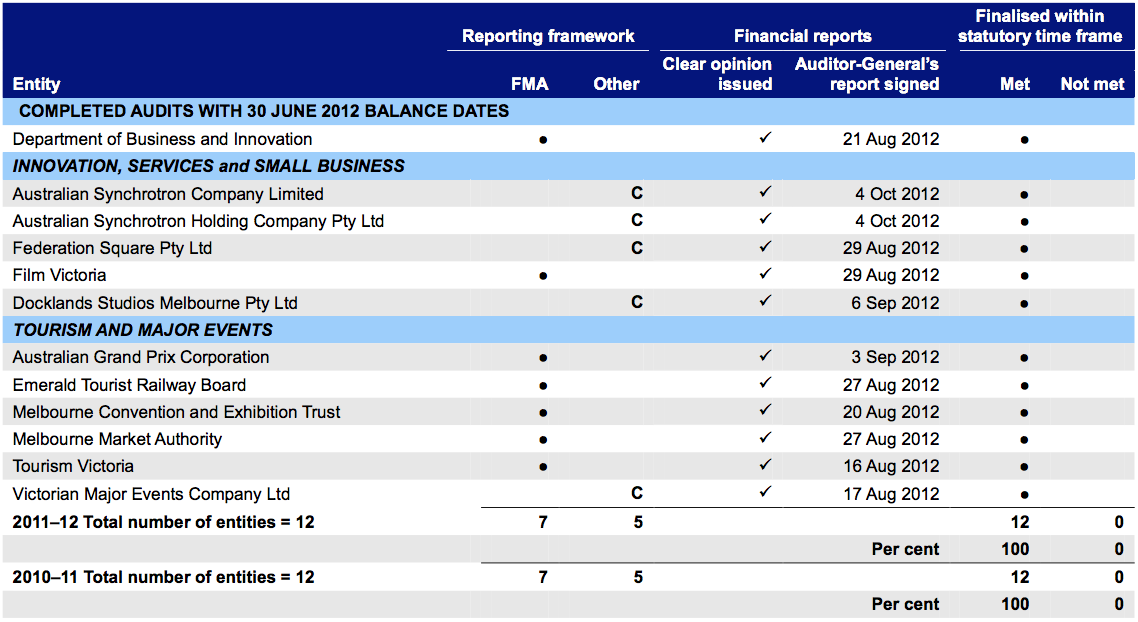
Note: Non-FMA audit types: C – Corporations Act 2001.
Source: Victorian Auditor-General’s Office.
Education and Early Childhood Development
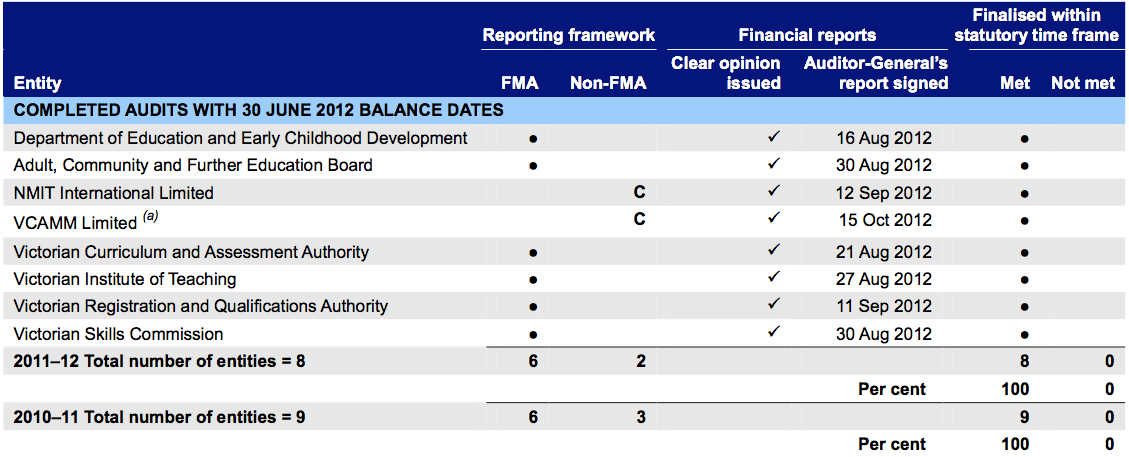
(a) VCAMM Limited is an audit by arrangement pursuant to section 16G of the Audit Act 1994.
Note: Non-FMA audit types: C – Corporations Act 2011.
Source: Victorian Auditor-General’s Office.
Health
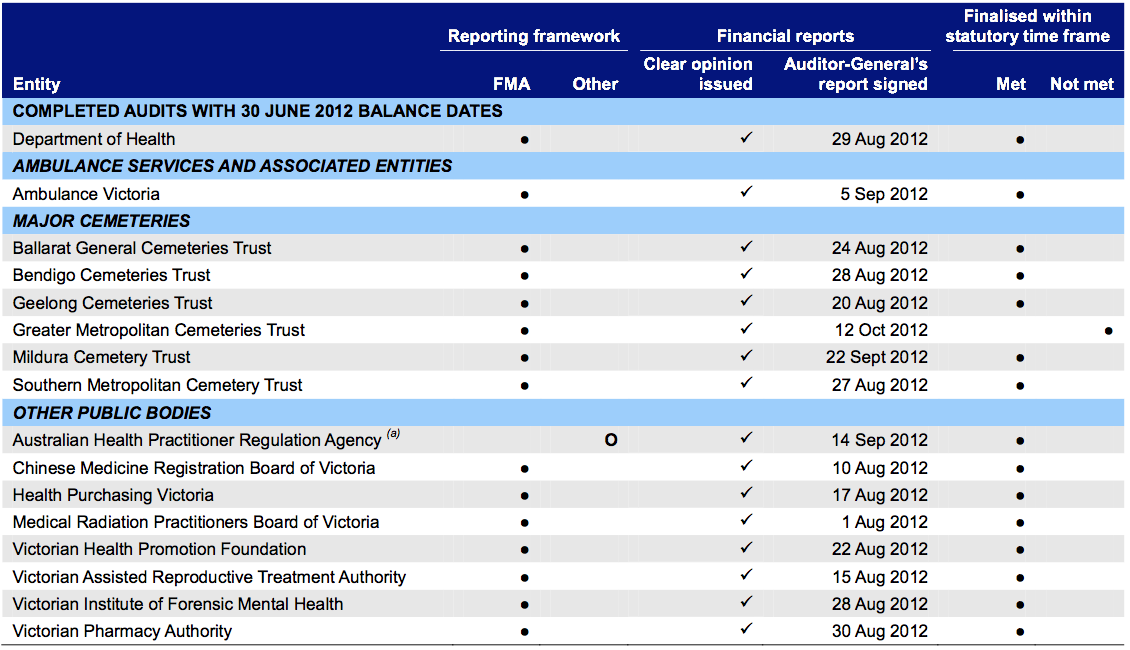
Health – continued

(a) The Australian Health Practitioner Regulation Agency is an audit by arrangement and does so in accordance with Australian Accounting Standards and the financial requirements of the Health Practitioner Regulation National Law Act 2009.
Non-FMA audit types: O – Australian Accounting Standards.
Source: Victorian Auditor-General’s Office.
Human Services

Source: Victorian Auditor-General’s Office.
Justice
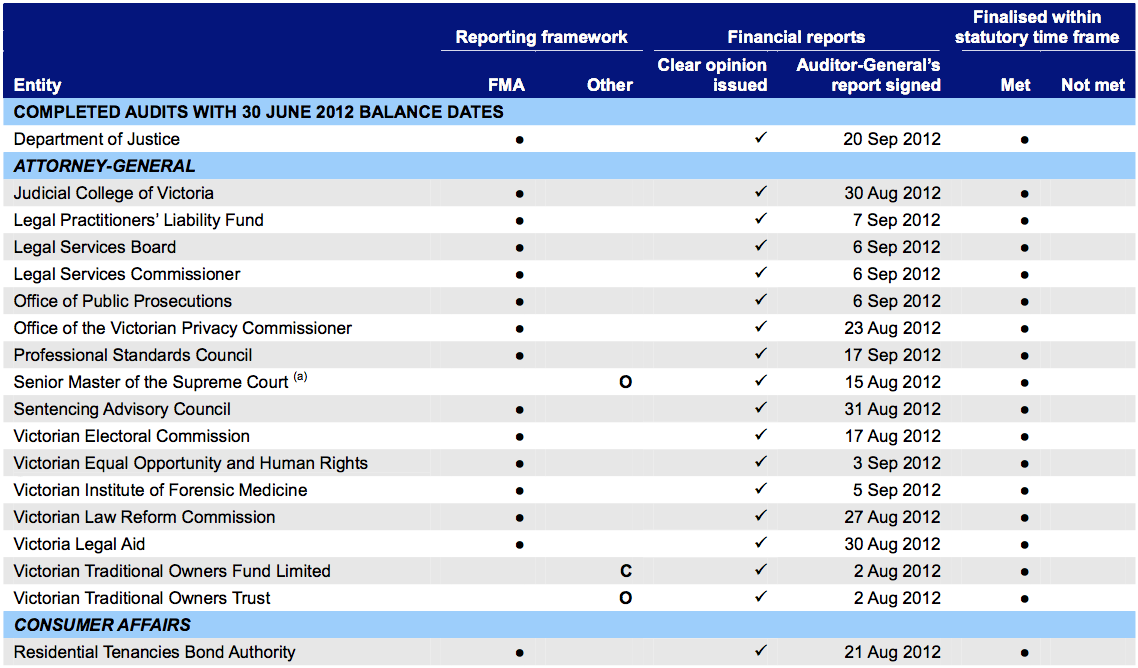
Justice – continued

(a) The Senior Master of the Supreme Court is an audit by arrangement pursuant to section 16G of the Audit Act 1994 and is not required to prepare a general purpose financial report, however does so in accordance with the Supreme Court Act 1986.
(b) Victorian Commission for Gambling and Liquor Regulation was wound up on 5th February 2012 and was replaced by the Victorian Commission for Gambling and Liquor Regulation as part of the machinery of government. Non-FMA audit types: C – Corporations Act 2001, O – Australian Accounting Standards.
Source: Victorian Auditor-General’s Office.
Planning and Community Development
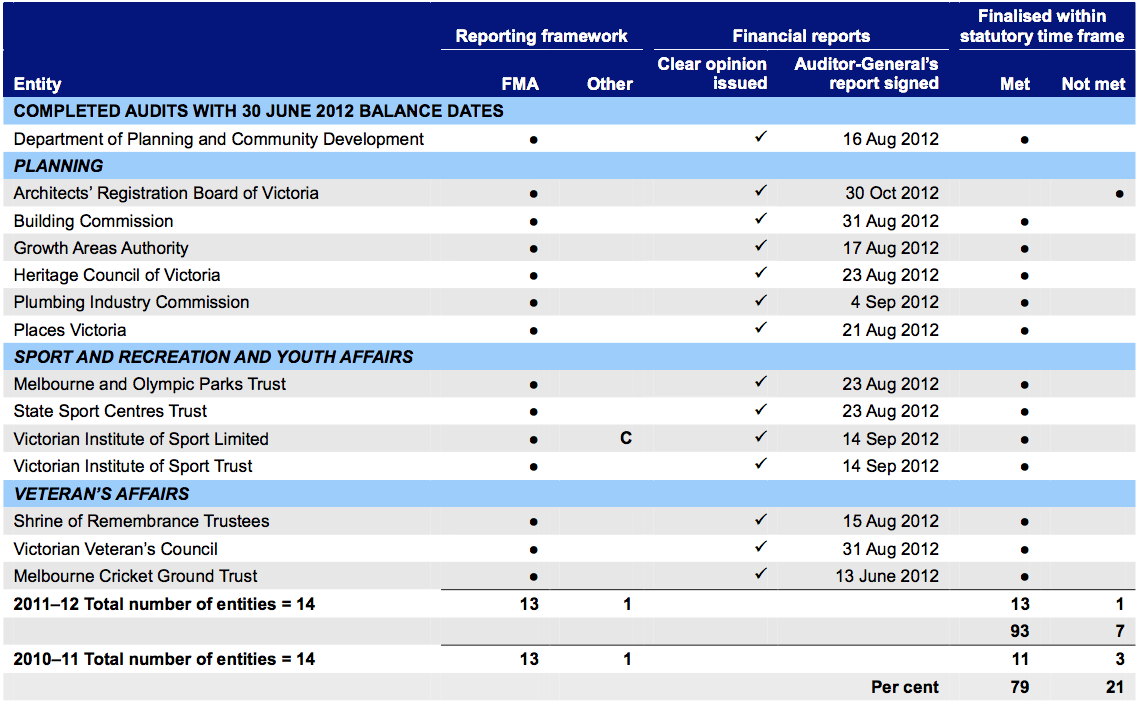
Note: Non-FMA audit types: C – Corporations Act 2001.
Source: Victorian Auditor-General’s Office.
Premier and Cabinet
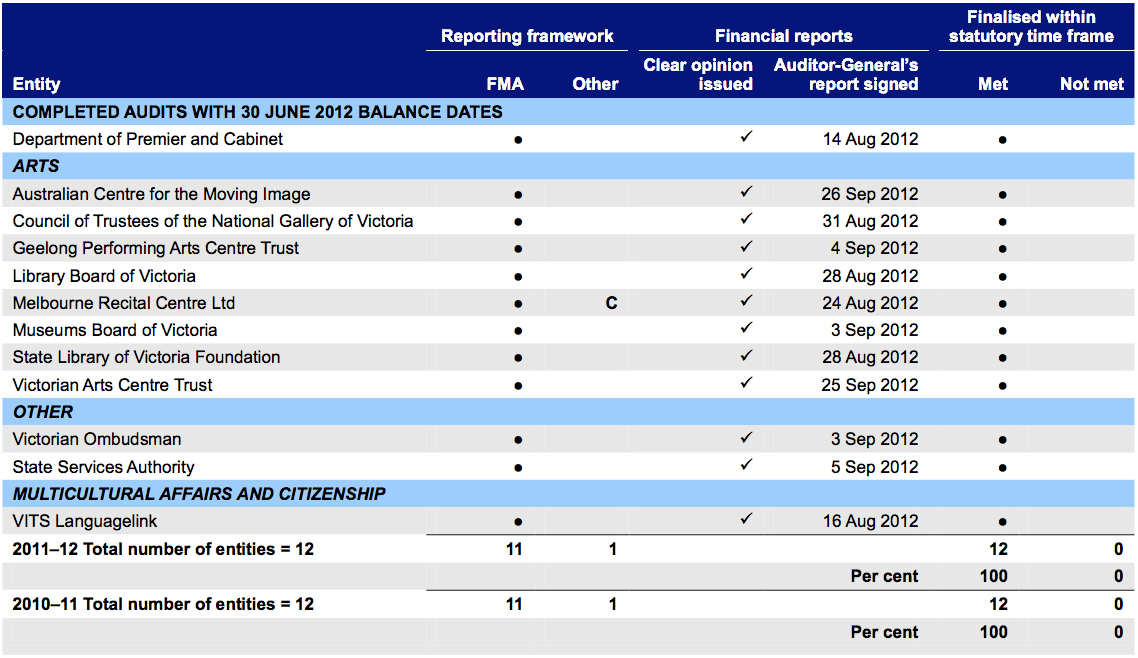
Note: Non-FMA audit types: C – Corporations Act 2001.
Source: Victorian Auditor-General’s Office.
Primary Industries
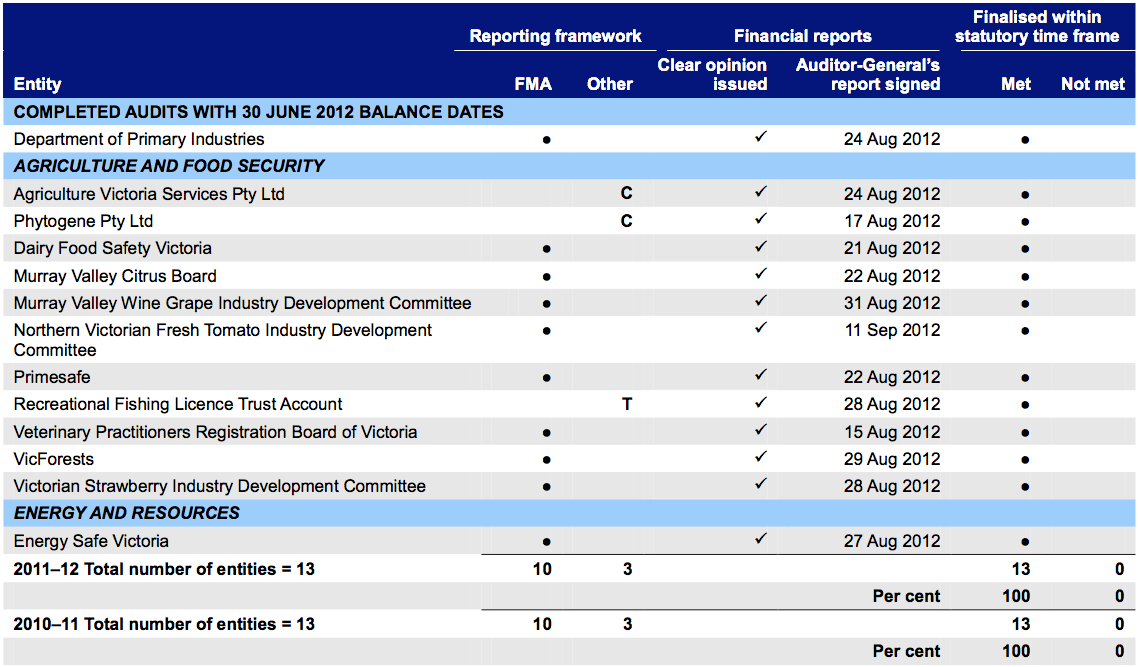
Note: Non-FMA audit types: C – Corporations Act 2001, T – Trust.
Source: Victorian Auditor-General’s Office.
Sustainability and Environment
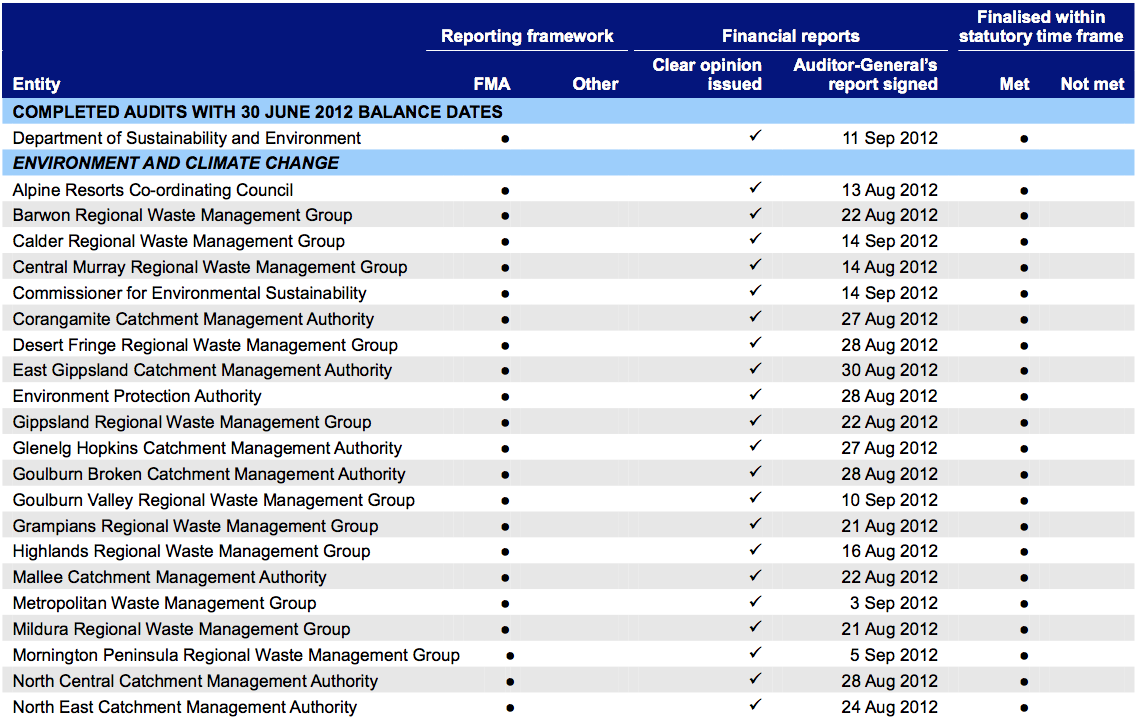
Sustainability and Environment – continued
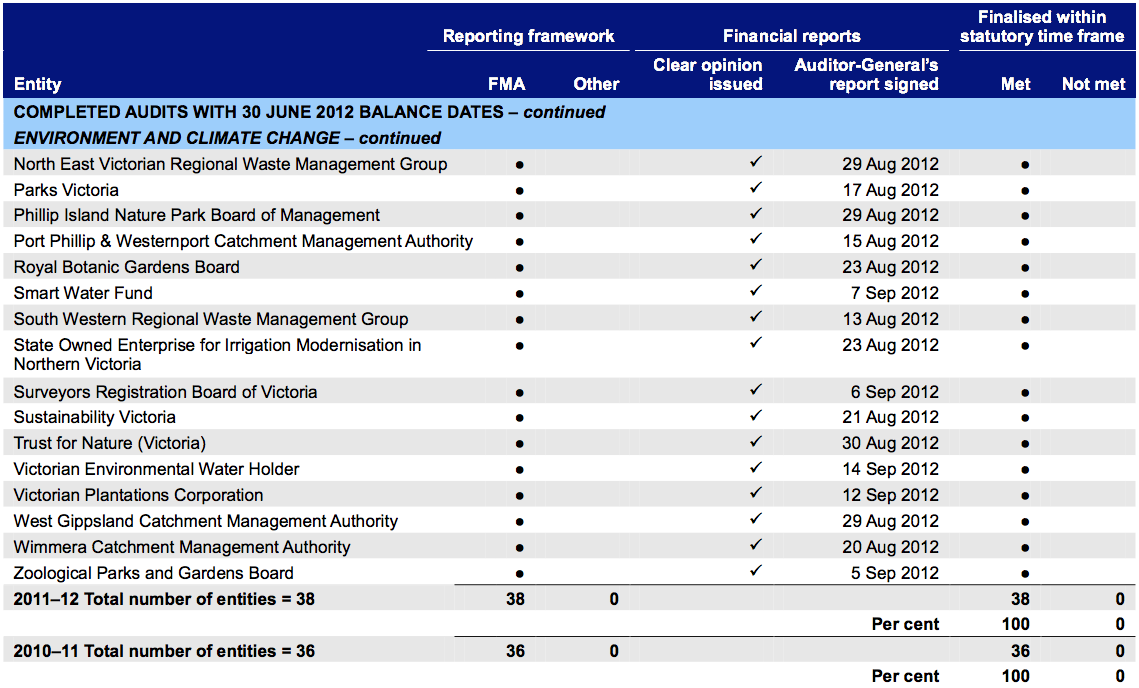
Source: Victorian Auditor-General’s Office.
Transport
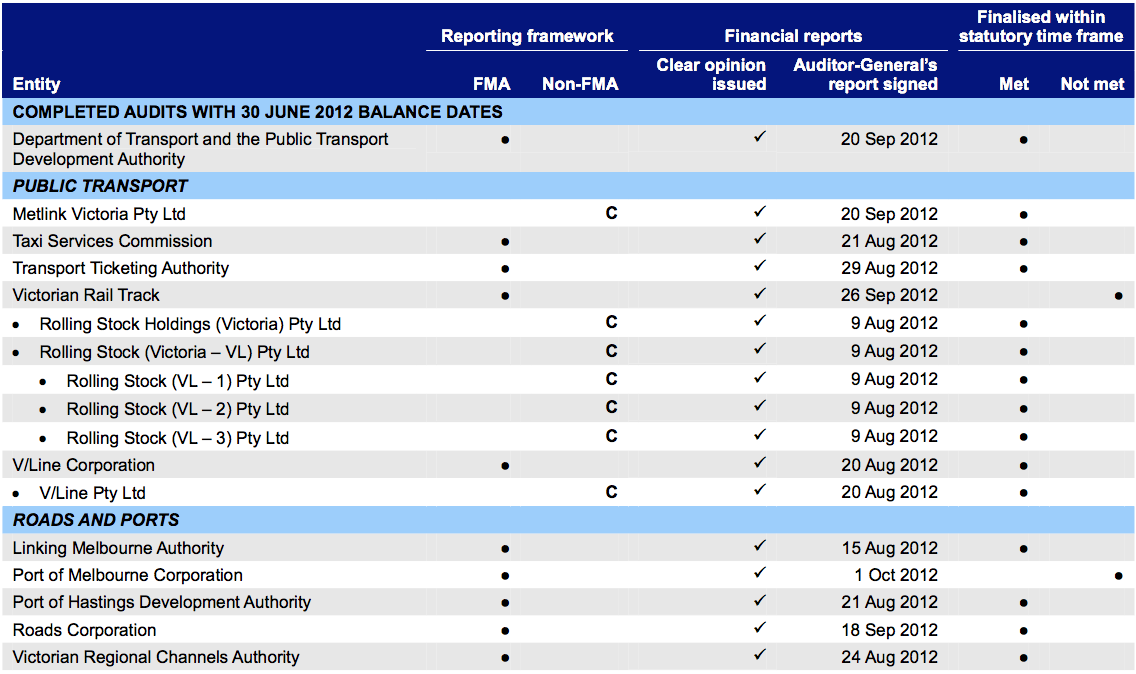
Transport – continued

Note: Non-FMA audit types: C – Corporations Act 2001.
Source: Victorian Auditor-General’s Office.
Treasury and Finance

Treasury and Finance – continued

Treasury and Finance – continued

Treasury and Finance – continued

(a) The audit opinion for the financial year ending 30 June 2011 for the State Electricity Commission of Victoria, and its 14 subsidiary entities, was signed on 20 December 2011.
Non-FMA audit types: C – Corporations Act 2001, O – Australian Accounting Standards, T – Trust Constitution.
N/A = Prepare financial statements in accordance with Trust Constitution. No statutory time frame.
Source: Victorian Auditor-General’s Office.
Appendix E. Acquittals
Public sector agencies are required, from time to time, to prepare acquittal statements to certify the spending of money has occurred for the purpose for which it was provided. Typically, these acquittals are prepared for Commonwealth-funded activities or capital works. Acquittal statements can be required to be audited by the Auditor‑General, or the Auditor-General can be asked to audit them in accordance with the requirements of a funding agreement.
This Appendix discloses the acquittal statements signed in the 2011–12 financial year.
Education and Early Childhood Development
Financial year |
Acquittal signing date |
|
|---|---|---|
Building the Education Revolution |
2010–11 |
8 June 2012 |
Source: Victorian Auditor-General’s Office.
Sustainability and Environment
Financial year |
Acquittal signing date |
|
|---|---|---|
SA/VIC Border Groundwater Project |
1 June 2011 to 31 May 2012 |
8 June 2012 |
Accounting for GDEs and Surface Water Systems |
1 June 2011 to 31 May 2012 |
8 June 2012 |
Groundwater SAFE (Secure Allocations, Future Entitlements) |
1 June 2011 to 31 May 2012 |
8 June 2012 |
Aligning Victorian NSW Cross Border Groundwater Management |
1 June 2011 to 31 May 2012 |
8 June 2012 |
Accounting for all Significant Water Uses |
1 June 2011 to 31 May 2012 |
8 June 2012 |
Framework for Determining Resource Condition Limits for Shallow Groundwater Resource Management in the Shepparton Irrigation Region |
1 June 2011 to 31 May 2012 |
8 June 2012 |
SA/VIC Border Groundwater Project |
1 June 2011 to 31 May 2012 |
8 June 2012 |
Source: Victorian Auditor-General’s Office.
Transport
Financial year |
Acquittal signing date |
|
|---|---|---|
Regional Rail Link project of the Nation Building Program |
2010–11 |
18 January 2012 |
AusLink Nation Building Projects Altona Intermodal Terminal Access Project |
2010–11 |
22 December 2011 |
AusLink/Nation Building Projects Urban Congestion Studies Project |
2010–11 |
22 December 2011 |
Nation Building Projects (VicRoads) |
2010–11 |
16 November 2011 |
Nation Building Program Funding for Land Transport Research Entities |
2010–11 |
16 November 2011 |
Interstate Road Transport Act 1985 |
2010–11 |
16 November 2011 |
Nation Building Program Black Spots Projects |
2010–11 |
16 November 2011 |
Nation Building Program Black Spots Projects Economic Stimulus Package |
2010–11 |
16 November 2011 |
Roads to Recovery Part 8 |
2010–11 |
16 November 2011 |
Source: Victorian Auditor-General’s Office.
Treasury and Finance
Financial year |
Acquittal signing date |
|
|---|---|---|
Natural Disaster Relief and Recovery Arrangements Claim |
2009–10 |
23 August 2012 |
Natural Disaster Relief and Recovery Arrangements Claim |
2008–09 |
27 April 2012 |
Source: Victorian Auditor-General’s Office.
Appendix F. Audit Act 1994 section 16—submissions and comments
In accordance with section 16(3) of the Audit Act 1994 a copy of this report, or relevant extracts from the report, was provided to all portfolio departments and named agencies with a request for comments or submissions. The comments and submissions provided for publication are not subject to audit nor the evidentiary standards required to reach an audit conclusion. Responsibility for the accuracy, fairness and balance of those comments rests solely with the agency head.
Responses were received as follows:
- Department of Treasury and Finance
- Department of Business and Innovation
- Department of Health
- Department of Sustainability and Environment


